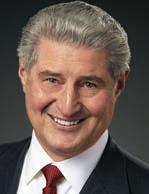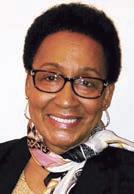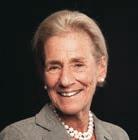HALL of FAME
Target’s East Harlem closure, blamed on theft, saddens area
Data show that retail theft has risen in the neighborhood, but some have questioned the retailer’s rationale for shutting the store
 By Nick Garber
By Nick Garber
When Target announced last week that it will close its sprawling East Harlem location because of rising retail theft, it brought an ignominious end to a department store that opened to great fanfare—and symbolic importance—more than a decade ago.
It arrived in 2010 as the rst Target to open in Manhattan and an anchor tenant in the new East River Plaza shopping center. e center replaced a former wire factory abutting FDR Drive between East 116th and 119th streets. For a decade prior, Target had been “wooing” Harlem leaders through dinner parties and charity work, the New York Times reported at the time, and the company set an “ambitious” sales goal of $90 million in its rst year.
BY THE NUMBERS
2010



When Target opened its store at East River Plaza in East Harlem

underserved neighborhood. “No one could have imagined.” e store itself is now an outlier in Target’s New York City eet: At 174,000 square feet, the East Harlem Target is fully big-box-sized—about four times larger than the typical “small-format” store that Target has since opened in other parts of the city. East River Plaza’s developers, Forest City Ratner and Blumenfeld Development Group, paired Target with other major retailers like Costco and Best Buy, and crowds ocked to each one on their opening days.
“ is was a pipe dream,” Xavier Santiago, chair of East Harlem’s Community Board 11, said of the 2010 opening in what has historically been an



It’s not clear whether Target will be breaking its lease by closing the East River Plaza location. Seven retail spaces at the complex are vacant, including a 55,000square-foot space on the oor above. By contrast, Target has announced plans to open another Harlem location about 1.5 miles away, as part of a brand-new development in
See TARGET on Page 26

ASKED & ANSWERED
Buildings are a key piece of the move to a green-energy economy in Robyn Beavers’ view.


PAGE 7

VOL. 39, NO. 34 l COPYRIGHT 2023 CRAIN COMMUNICATIONS INC. l ALL RIGHTS RESERVED CRAINSNEWYORK.COM I OCTOBER 2, 2023
GIANTS
Village’s Whizz rents e-bikes to delivery workers with unlimited repair and maintenance. PAGE 3
CHASING
West
15 10th
Read about ve leaders who have made a mark in business, the arts and health care.
PAGE
Anniversary
Quenia Abreu (clockwise from top left), Jonelle Procope, Ken Raske, Michael Pugh and Robert Battle BUCK ENNIS
The East Harlem Target opened in 2010 as an anchor tenant in the East River Plaza shopping center. | BUCK ENNIS
EVENTS CALLOUT OCTOBER 26
HALL OF FAME
In a city full of dynamic, inspiring and enterprising business executives, it was no easy task to arrive at our final class of 2023 inductees to celebrate our 10-year anniversary. This year’s honorees are among an extraordinary group of peers who have transformed our great city through their professional work as well as their civic and philanthropic activities. Crain’s will recognize the honorees at this celebratory luncheon.
DETAILS
Location: Midtown Loft & Terrace CrainsNewYork.com/halloffame2023

Silverback Development founder sued over another alleged debt
By C. J. Hughes
Joshua Schuster, who blazed to real estate glory in his early 30s by launching a luxury development firm but has spent many of the years since battling with creditors over alleged unpaid debts, has been hit with another bill.
Schuster owes $250,000 to a landlord for unpaid rent, utility bills and other expenses at a luxu-
years, most over outstanding debts. Judges have dismissed some of the claims but ordered judgments against Schuster in others, records show.
He appears to have lowered his profile in New York in recent years. On Sept. 21, the phone at Silverback’s Midtown office appeared to be disconnected, and an email sent to the firm’s media contact was not returned. Schuster is living in Boca Raton, Florida, according to the Sept. 20 complaint.
according to the suit. Only after Mitchell filed court papers to begin eviction proceedings in March did Schuster agree to go.
Developer came out strong
ry building on the Upper East Side, according to a complaint filed Sept. 20 in Manhattan Supreme Court.
Last year, Schuster stopped paying rent for his three-bedroom duplex at the condo conversion 320 E. 82nd St. before moving out this spring, court filings say.
Schuster, who founded Silverback Development in 2016 at age 32, has not yet filed a legal response in the case, one of more than a half-dozen suits brought against him in Manhattan Supreme Court in the past several
In 2020, Schuster moved into apartment No. 1 at 320 E. 82nd St., a maisonette-style multifloor unit featuring herringbone floors, a greenhouse glass-covered dining area and a kitchen with quartzite counters and a wine refrigerator. His rent in the building, which underwent a condo conversion pre-pandemic, was $17,500 a month.
A year later, Schuster renewed his lease at a rent of $20,000 a month but stopped paying shortly after, the suit says.
The landlord of the building, developer Mitchell Holdings, told Schuster he had to move out by October 2022, but he did not do so,
Mitchell, whose principal is David Mitchell, alleges Schuster owes $220,000 in back rent plus $14,500 in unpaid utilities and $15,000 in legal fees. Mitchell purchased the building, a former residence for pregnant teens, in 2015 for $16 million and created six condo units there under a plan to make $35 million, according to state documents. He appears to have sold only three of the units since marketing began in 2017.
Silverback, named for a type of gorilla leader, came out of the gate strong with projects such as Hero, a 22-story, 109-unit condo at 2416 Queens Plaza in Long Island City that opened in 2020. But complaints about leaks, broken fans and non-functioning elevators quickly piled up at the project. Repairs were slowed by supply chain constraints brought on by the pandemic, Schuster said at the time.
The pandemic similarly forced Silverback to abandon plans for a
SOLVING THE GREATEST CHALLENGES IN HEALTHCARE
condo conversion at a college dorm at 67 Livingston St. in Brooklyn Heights and turn it into a rental instead, he said. The firm owns other sites in Connecticut and Florida.

Schuster, whose previous New York employers were developers JMH Development and DHA Capital, was also battling creditors along the way. Nick Lettire, co-founder of Lettire Construction, alleged in one case that he lent Schuster $1.5 million for what he thought was a development project but that Schuster instead dipped into the funds for himself. Schuster denied the allegations in the case, which appears unresolved. His legal challenges have not been limited to New York real estate. On a judge’s orders, the 39-year-old Schuster had to fork over $30,000 in unpaid gambling debt this summer to the Mirage casino in Las Vegas, court filings show.
Eric Kahan, Mitchell’s lawyer in the case, declined to comment.
2 | CRAIN’S NEW YORK BUSINESS | OCtOBER 2, 2023
With more experts across all specialties working together, we’re Raising Health for more people in New York than anybody.
MORE EXPERTS. DEEPER INSIGHTS. NEWER BREAKTHROUGHS.
Schuster appears to have lowered his profile in New York in recent years.
320 E. 82nd St. | CORCORAN GROUP
E-bike startup offers lifeline to delivery workers
the West Village company Whizz rents e-bikes with unlimited repairs and maintenance for a monthly fee
The upstart: Whizz

Orville Feanny, who lives in Brooklyn and works as a DoorDash and Uber Eats delivery driver, has given up on owning his own e-bike. The two he bought were both stolen. He was also paying more than $100 a month for maintenance and repairs, he says, and he couldn’t work when his e-bike was in the shop.
Last year, Feanny started renting an e-bike from Whizz, a startup based in the West Village. The monthly fee includes unlimited maintenance and repairs. And if a repair takes more than 30 minutes, Whizz gives him a loaner. “It’s more convenient,” he says. “And it’s a good deal. Personally, I earn $200 a day, so the bike is paying for itself in a day or two.”
Whizz was launched at the start of 2022 by co-founders Ksenia Proka and Alex Mironov. The married couple had founded a similar e-bike rental company in Moscow and sold it to a Russian hedge fund before moving to New York. They were soon joined by co-founder Mike Peregudov, who had launched and sold the largest meal kit company in Russia. “I met them for dinner and decided to invest,” says Peregudov. “I first wrote a small check, but I quickly realized that it’s a really cool opportunity, and I somehow got full-time involved as CEO.” A fourth co-founder, Chief Technology Officer Artem Serbovka, lives in Dubai.
The company now rents 1,000 e-bikes to the same number of delivery workers in New York City. Monthly rates, which include unlimited maintenance and repairs at its warehouse locations in the West Village and Bushwick, Brooklyn, range from $149 to $169 a month depending on the e-bike model.

Fueled by $4.5 million in funding, which includes a $3.4 million seed round that closed in May, Whizz is looking to raise a $10 million to $15 million Series A round early next year. Its annual revenue topped $3 million in August, triple the year before. It employs a team of 50, half of whom work in the warehouses or in customer service, the other half in
the office.
The company has big ambitions, says Peregudov. It will soon open a third location in Midtown—one of the world’s densest food delivery zones—and is scouting a fourth in New Jersey. Within four years, he forecasts, Whizz will be renting electric vehicles—including e-bikes, mopeds, cargo bikes, small cars and trucks—to more than 30,000 of New York City’s 100,000-plus delivery workers.
Among the company’s investors is Harry Campbell, whose online “The Rideshare Guy” publication is read by millions of rideshare and delivery workers.
Whizz’s rates are affordable even to city delivery workers, who typically can’t afford to buy their own e-bike, he says. “And the support system, the downtime it avoids, is very valuable.”
While New York’s heavy reliance on e-bikes and mopeds for delivery is unusual, he says, there’s potential for growth nationwide. Roughly 90% of all food orders are delivered by car. “There’s a huge mismatch between the vehicle type and what’s needed,” he says. “Most food deliveries are small.”
The reigning Goliath: Zoomo
Based in Sydney, Australia, the rival e-bike rental service operates 15 locations in Australia, Europe and the U.S., including one in Manhattan’s Garment District. It is backed by $101.5 million in venture funding.
How to slay the giant
Rather than purchase an existing model, Whizz had its own e-bikes manufactured in China. They are specially designed for delivery workers, says Peregudov. They endure heavy use—typically 600 to 700 miles a month—and offer a long battery life. To protect against theft, they include a GPS tracking system that can remotely disable the motor and wheels.
The equipment also meets the city’s new certification guidelines for e-bike quality and safety. There have been zero Whizz e-bike battery fires since the company was launched, says Peregudov.
The bikes are also the company’s biggest marketing tool. The original model was black, but Whizz soon converted to neon green. “Because they are bright and in the streets, it’s literally free advertising,” says Peregudov.
The company recently launched a referral program which now accounts for 15% of new subscriptions. And in August, it partnered with DoorDash. The delivery service will be offering a discounted Whizz rental to new employees.
But the company’s biggest asset is its software, developed in-house by a team of seven, says Peregudov. The tech has a risk assessment component that estimates the odds of a rider stealing a bike. Whizz says this has kept theft to a minimum—about five bikes a month. A demand prediction function, meanwhile, factors in variables such as day of the week and weather to optimize warehouse staffing levels.
The company has also started using ChatGPT to handle service queries, which will allow its team of 10 service reps to double the number of e-bike customers it can support, to 2,000. These efficiencies, Peregudov says, allow Whizz to offer rates 20% below its rivals. In a market where customers are price-sensitive to the extreme, that’s a big advantage.
The next challenge
Whizz is thinking far beyond New York City. It plans to expand to major markets across the U.S. and Canada, offering a range of electric vehicles including mopeds, cargo bikes and new designs.
It’s also in talks with major companies to provide vehicles to their employees. “We want to be the largest company in the US providing an electric fleet for last-mile delivery,” says Peregudov. “Our vision is that we will manage a fleet of 100,000 vehicles in five years. We want to grow fast!”
OctOber 2, 2023 | crAIN’S NeW YOrK bUSINeSS | 3
Anne Kadet is the creator of Café Anne, a weekly newsletter with a New York City focus.
CHASING
GIANTS
Anne Kadet
Whizz co-founder and CEO Mike Peregudov | bUcK eNNIS
Fashion designer known for anti-hate efforts lists co-op
Phillip Lim could double his investment in the full-floor two-bedroom unit in a landmark district
By C. J. Hughes
Fashion mogul Phillip Lim is ready to shed his SoHo co-op.
The minimalistic designer has listed his pared-down two-bedroom, two-and-a-half bath unit at 19 Greene St. for $8.5 million, according to a listing that appeared on StreetEasy last week.


The apartment, a combination of two units that sweeps across the entire fourth floor, features a SoHo-style open floor plan, though the primary suite has a large walk-in closet. Sporting a cast-iron façade, the seven-unit, five-story mixed-use building, which is near Canal Street, also sits in an historic district.
an opening in a wall and combining the side-by-side units. The kitchen in the front apartment survives as a wet bar. Lim spent $4.2 million on the real estate alone, which suggests he could double his investment if his home sells at its asking price, less any renovation costs.
$8.5M
The apartment is also being marketed as a rental at $45,000 a month, according to StreetEasy.
List price for Phillip Lim’s co-op at 19 Greene St. in SoHo
Turnover in the building seems rare. The last apartment to sell was in 2016, when a two-bedroom traded for $3.3 million, according to city records.
Lim first purchased the rear unit,
It’s not clear where Lim is moving. Esteban Gomez, the Compass agent with the listing, did not return an email, and an effort to contact Lim through his company’s website was unsuccessful.
The apartment features a SoHo-style open floor plan, though the primary suite has a large walk-in closet.
No. 4R, in 2007 for $2.3 million, according to the city register. Four years later, he added on the front apartment, No. 4F, which cost $1.9 million, before apparently creating
Born in Thailand to parents who had escaped from Cambodia during its civil war and previously fled from China during its Communist revolution, Lim grew up in Southern California, where his mom worked as a seamstress.
In 2005 during New York Fashion Week, Lim and a friend, Wen Zhou, launched 3.1 Phillip Lim, a line known for its playful and often monochromatic pieces. Former first lady Michelle Obama is re-
portedly a fan. About a decade ago, the company opened a short-lived boutique at 115 Mercer St. before moving to 48 Great Jones St. in NoHo, which is still in operation today. But most of 3.1’s boutiques are overseas, including in China, Thailand and Japan.
Last winter, after a series of Asianhate incidents, Lim and four Asian-American fashion-industry friends—Prabal Gurung, Laura Kim, Tina Leung and Ezra William—launched an online comic strip called “House of Slay” to “take
on racism, hatred, bullying and fear of the ‘other.’”
Three years ago, Lim designed a sweatshirt adorned with the words “Beirut. Tougher than ever” written
in both English and Arabic to help raise money for the victims of a massive 2020 explosion in Lebanon that killed 218 people and caused $15 billion in damage.
Adams shortens migrant shelter stays to 30 days as system strain to provide for asylum-seekers continues
By Nick Garber
Mayor Eric Adams implemented a new 30-day maximum stay in the city’s shelter system for single adult migrants, cutting in half the 60-day rule he announced months ago and further narrowing the city’s interpretation of its right-to-shelter mandate.
The new one-month cap, announced Sept. 22, will apply to adult migrants entering shelter for the first time and also to those who are reapplying to stay in shelter after receiving a previous 60-day notice.
Although bound to be controversial, officials called the move necessary to provide for the more than 60,000 asylum-seekers who are in the city’s care—among the 116,000 total migrants who have entered the city since last spring.
“We have now reached a point where we are full and must take action to move people seeking asylum more quickly through our shelter system,” Anne Williams-Isom, the city’s deputy mayor for health and human services, said in a statement. “The accelerated pace of stay in our shelter system will be paired with intensive case management to help people seeking asylum speed up their ability to achieve independence.”
The city has so far issued about 13,000 notices to migrants that have reached the existing 60-day cap. Although people unable to find alternative housing have the chance to reapply to stay in shelter, advocates and some elected officials have warned that caps could lead to more people sleeping on the streets.
City Hall had telegraphed that a new cap might be imminent. The administration has even considered extending the 60-day limit to families with children, according to some reports, al-
though no such policy was announced Sept. 22.
The Legal Aid Society, which is battling the Adams administration in court over its efforts to limit the city’s right-to-shelter mandate, said earlier last week that a 30-day cap would be “pointless, cruel, and another bureaucratic hurdle” for new ar-
rivals.
“Such policies will inevitably lead to more confusion and more people sleeping on rough streets and in our subway system, parks and other public areas—a scenario that no New Yorker wants, especially with winter approaching,” Legal Aid said in a joint statement with the Coalition for
the Homeless. “For families adjusting to new schools and new routines, these punitive rule changes will only add to their burden.”
City Hall said each migrant given a 30-day notice will be given “touchpoints with caseworkers” over the course of that month to plan their next steps.

4 | CRAIN’S NEW YORK BUSINESS | OCtOBER 2, 2023
RESIDENTIAL SPOTLIGHT
19 Greene St., SoHo COMPASS
Although bound to be controversial, officials called the move necessary.
The new 30-day cap, announced Sept. 22, will apply to adult migrants entering shelter for the first time and also to those who are reapplying to stay in shelter after receiving a previous 60-day notice. BUCK ENNIS


AN IAN SCHRAGER HOTEL 215 CHRYSTIE STREET, NEW YORK WWW.PUBLICHOTELS.COM LUXURY FOR ALL A NEW IDEA FOR A NEW AGE
Penn Station ruling deals a blow to transparency
A judge said she wasn’t in a position to second-guess the state’s economic development arm—and that’s a problem
Opponents of Gov. Hochul’s plan to pay for a new Penn Station, which envisions harvesting tax revenue from 10 new supertall towers in the area, su ered a defeat last month when a state judge dismissed their lawsuit.
e plainti s had alleged that state o cials acted arbitrarily and capriciously when they teamed up with Vornado Realty Trust to build the towers. But Judge Lucy Billings said she was in no position to second-guess decisions made by the Hochul administration’s economic-development arm, Empire State Development.
“ e court may not substitute its judgment for ESD’s,” Billings wrote in her ruling.
e trouble with that reasoning is that little is known about how ESD reached its judgments regarding Penn Station. e public has a right and need to know what sort of deal ESD made with Vornado because the proposed 18 million-square-foot development would be larger than Hudson Yards. Not for nothing, Vornado CEO Steven Roth has called the project his “promised land.”
But some basic questions re-
main unanswered: How much revenue might the project produce for developers and their institutional investors? What sort of tax incentives were they o ered to redevelop an area the state has called blighted? And how much of the pot of money actually goes to rebuilding the god-awful Penn Station?
Answers were sought by the Penn Community Defense Fund, the City Club of New York and ReinkNYC. Last year they sued ESD for the information, but Judge Billings’ ruling means it will remain under wraps.
Chuck Weinstock, an attorney for the plainti s, said the judge’s ruling is so deferential that it will be di cult the next time citizens turn to the courts to nd out how a state agency made a decision it’d rather not talk about.
“Over time, New York courts have limited themselves to let agencies do whatever they want,” he said. “Under this ruling, every agency action can survive.”
e answers sought by the community groups are likely contained in a report by Ernst & Young. But the report has never been made public because, ESD argued, it was a draft and only -
nal reports must be exposed to sunshine. Presumably if the report contained good news the agency would be pleased to share it.
‘Bereft of evidence’
e community groups weren’t the only ones who smelled something shy. e late Dick Ravitch, the former MTA chief, lieutenant governor and the most respected businessman in New York, said he was “genuinely outraged” by ESD and said the agency was acting “recklessly” with “a gift” of 18 million square feet of Manhattan real estate to private developers.
“ESD certainly has a good cause—rehabilitating Penn Station,” Ravitch said in an a davit to the plainti s’ case, “but it has altogether failed to explain why that requires a real estate giveaway on this scale.”
Given the sad state of the o ce market, Hochul recently pivoted and said she’ll try to nd a way to x Penn Station without Vornado building towers. Even so, her plan to transform the surrounding neighborhood into a new Hudson Yards is still alive.

“ e plan was always a real estate boondoggle in search of a public purpose,” Weinstock said. “ESD at-out abandoned their original justi cation for the plan—
xing Penn Station—and then contrived this new one but never—not once in the entire litigation—tried to back it up. Honestly, we’re surprised that the judge took them at their word.”
He added: “ eir defense was bereft of evidence or legal support; they’re plowing ahead with this plan because that’s what the developers—their benefactors— want them to do.”
ESD spokesman Matthew Gorton described the judge’s ruling as “straightforward” and

“clear-sighted.”
“ESD appreciates the merits of the state’s position being heard and upheld by the court,” he said.
Weinstock and another lawyer for the plainti s, Richard Emery, say they are looking to appeal the judge’s decision.
Whichever way this ght shakes out let us pray that, speedily and in our time, the outcome is a better Penn Station. Every day, 600,000 commuters pass through the station that Hochul accurately calls a “hellhole.”
Biden should see the migrant crisis as a chance to revitalize cities and towns around the U.S.
The president’s rst step on work permits for Venezuelans should build toward a bigger, nationwide resettlement plan
Last month, the Biden administration nally agreed to expand temporary protected status for Venezuela, making close to 500,000 asylum seekers freshly eligible to apply for work permits. Gov. Kathy Hochul, Mayor Eric Adams and many other Democrats had pushed the White House to enact the policy, which will last 18 months and allow as many as 60,000 Venezuelans in the city to quickly acquire permits and head to work.
Conservatives hate this because they want closed borders and reduced immigration. Tools like TPS, they argue, will only incentivize more migrants to try to enter the country illegally and hope for protection later.
e Biden administration does need to get control of the border. But this also means rationalizing and streamlining immigration
policy so new migrants aren’t mired in years of bureaucratic red tape before being able to work and pursue a path to citizenship.
With a declining birthrate and depopulating Rust Belt cities, the United States needs fresh infusions of human capital. e right-wing demonization of immigrants always carries with it a whi of irony. ose who risk their lives to come here are, in fact, a self-selected bunch: the most ambitious and fearless a foreign nation has to offer.
Over time, migrants from Venezuela and elsewhere can revitalize cities and towns alike—starting families, paying taxes and enlivening neighborhoods. It’s an old story. For over a century, immigrants from across the world have been reinvigorating the U.S.
Given all of that, Biden
shouldn’t feel he can take a victory lap after TPS. Work permits are a great start. But New York City can’t be the only major destination for migrants across the world.
The Biden administration must begin coordinating with Democratic mayors and governors across America to create a fair system where a certain percentage of migrants are settled in each city, with priority for counties that have experienced the most population loss. The federal and state governments can partner to provide social services, but the reality is, with work permits, there won’t need to be any dramatic expansion of the safety net.
Instead, a labor need will be met.
e many restaurants, hotels, construction companies and farms that have been struggling to attract workers will now have a new talent pool to choose from. e migrants themselves are hungry to work because they didn’t ee catastrophe in Venezuela to be destitute here. ey want to earn money for themselves and send a chunk of it back home.
In time, they might not even want to remain in the United States. Conservatives rarely note that Mexican migration, over the past decade, mostly declined. is recent wave will eventually abate, too. e new arrivals should be viewed as an opportunity for revival.
In the meantime, it will be up to Adams to communicate reasonably with the public. In ammatory rhetoric about migrants coming to “destroy” New York City will only worsen the city’s re-
lationship with the federal government and embolden xenophobes. Adams, if he continues on this path, will do irreparable damage to his legacy.
Quick takes
◗ Adams and Hochul are wrong to push for the end of New York City’s right-to-shelter law. At some point, the number of migrants coming into the city will level o , and street homelessness could come to resemble the West Coast if shelters start shutting their doors.
◗ Dan Garodnick, Adams’ commissioner of the Department of City Planning and a former City Council member, is on the verge of successfully implementing new zoning laws that will make it easier for working class people to live here. Garodnick should be commended, in particular, for envisioning new rules to kick o an SRO revival.
Ross Barkan is a journalist and author in New York City.

6 | CRAIN’S NEW YORK BUSINESS | OCTOBER 2, 2023
IN THE MARKET
Aaron Elstein
Penn Station | BUCK ENNIS
ON POLITICS
Ross
Barkan
For over a century, immigrants from across the world have been reinvigorating the U.S.
ASKED & ANSWERED
Making buildings more profitable through sustainability
In the years that followed Superstorm Sandy, Robyn Beavers co-founded Midtown-based Blueprint Power to combine her two loves: energy and real estate. The conditions were right as New York began to embrace a more resilient power grid. Policymakers and energy industry leaders were paving the way for things like solar panels and batteries in buildings, and starting to make such projects more financially attractive for property owners. That’s where Blueprint Power factored in. The climate technology company, which was acquired by BP in 2021, built a software platform to help buildings harness flexible energy capacity while also growing revenue. Fast forward to 2023 and that work has become even more critical as owners and property managers work to get their buildings in compliance with green mandates without breaking the bank. As Beavers sees it, buildings are a core piece of the transition to a green energy economy, and that can also mean more greenbacks for property owners. | Interview by Caroline Spivack
Is a mindset shift occurring in the real estate industry on how green retrofits can be monetized and not necessarily be costs owners need to eat?
I think that mental shift is happening and needs to continue to happen. There’s money on the table for green buildings in a few different ways. There are market revenues for buildings that can transact on the grid. Investing in your building to access those revenues can lead to high return investments for your property. The second way is, there’s more data points showing that green buildings versus [buildings that aren’t as energy efficient] are more valuable. It’s going to be more attractive to the tenants that are increasingly looking for green buildings to lease, and in general, there are a lot of updates happening to underwriting for buildings that are more sustainable.
What are some ways buildings can grow revenue while shrinking their carbon footprint?
Behind-the-meter distributed energy assets you can bring to your building, whether it’s a solar array on the roof, a battery that you can put in your basement or around your building, EV chargers. We like EV chargers because they’re also valuable when it comes to flexible energy. And then also look at your major building systems, like your HVAC. When you bring or start paying attention to those types of assets at your buildings, you basically are able to respond and transact in grid markets.
What are some of the most commonly overlooked opportunities to make buildings green?
Always look at what exists in the building; usually it’s just underoptimized or underutilized. There is a myth that things like
solar or other additions to your building are too expensive. What’s great is there’s high interest for bringing EV charging as an amenity for tenants, but as I said earlier, EV chargers are also part of this energy solution. So we like to educate our partners, saying, “It’s not just an amenity; it’s part of your net-zero strategy as well.”
Are there specific financial incentives you point building owners to?
It’s very important to evaluate financial incentives at the federal level, the state level, the utility level and the local level. There are often different buckets of incentives, whether they’re cashbased or tax credits. When you can stack up a few different things, it often can contribute significantly to that return on your project.
What would you like to see from the public sector to help get projects done?
My big message is in the getting
stuff done area, which is usually around permitting, interconnection, streamlining the processes to get physical clean-energy access inside a building. Buildings are so interesting because they’re touched by multiple agencies within a local region, but then to do all this climate work, you’re also impacted—in a good or bad way—by state and federal laws too. You have different policy layers, and you gotta thread that needle.
Dossier
Who is she ce O of b lueprint
Grew up b oston area Resides Sleepy Hollow, Westchester Education b achelor’s in civil engineering and b A, Stanford University Child model For a time when she was a child, eavers’ family lived in okyo, where she had a modeling career that eventually helped her pay for her civil engineering degree at Stanford. “ t hat was my first entrepreneurial hustle, I guess, at age 5,” she said.
Google gig One of b eavers’ first jobs out of college, in the early 2000s, was at Google, where she worked directly for the co-founders as a sort of assistant, taking on all kinds of tasks. “I like to describe it as he Devil Wears Prada’ for nerds,” she said. b eavers became the founding member of Google’s green business and operations strategy team. She helped the company build out its global offices with green features, which helped launch her career.
Green Market Report names NY cannabis award winners
Navigating the New York cannabis market these days requires resilience and creativity—just a few of the characteristics shared by the winners of the first ever Green Market ReportNew York Cannabis Awards.

The awards were announced at the GMR New York Cannabis Summit in New York City on Sept. 13.
Here are the 2023 award winners:
Best dispensary: Housing Works
Cannabis Co.
Sasha Nutgent, general manager

Running the sole legal dispensary in New York City during winter 2023, Sasha Nutgent trained and equipped a dynamic team of more than 50 individuals who handled that demand, established effective pickup and delivery options, and built public confidence in legal cannabis. This high-traffic dispensary processes more than 1,000 daily transactions on its busiest days and has exceeded $12 million in sales in just six months.
Best brand: Matter by PharmaCann Bryan Benavides, director of digital marketing, and Brett Novey, chief executive PharmaCann recognized right
away an opportunity to produce a high-quality consumable product that would appeal to consumers whose tastes run beyond vaping and smoking. The result is an extension of the Matter brand, featuring an array of consumable products that feature high-quality ingredients and flavors, as well as a variety of products to suit any preference. Known for their quality and consistency, Matter products have been showered with kudos in multiple states—and have become one of the most popular product lines in New York.
Best lawyer: Benjamin Rattner cermele & Wood LLP
The New York market is anything but straightforward, but according to a couple of Ben Rattner’s clients, he served as their “guiding light.” He helped interpret and comply with the multifaceted regulations, as well as providing guidance to strategically maneuver through challenges. “His commitment to our success was evident in the countless hours he spent understanding our unique needs, and then meticulously crafting solutions tailored to our situation,” they said.
Best ancillary provider: KCSA
Lewis Goldberg, managing partner and principal
In 2014, KCSA Strategic Communications jumped headfirst into the budding cannabis industry. Today, KCSA works across and supports the entire cannabis supply chain,including major Canadian LPs, the biggest multistate operators in the U.S., international cultivators in Colombia, ancillary service providers, and sources of capital.
Best ancillary provider-Nonprofit: Hospitality Pathways
Beatrice Stein, founder and director
After the Covid-19 pandemic wreaked havoc on the hospitality world, Beatrice Stein pivoted to the cannabis industry and established her new nonprofit, Hospitality Pathways. Her goal, then and now, was to give disenfranchised population the training, skills, and confidence they need to succeed in the retail cannabis industry. Her students now work in every legal retail location in the five boroughs and represent some the highest sellers
and the most requested of their peers.
Best place to work: Bison Botanics
Frank Shultz, chief executive Bison Botanics is a pillar in the Buffalo and Western New York community. This reaches far beyond the cannabis realm and has spilled over into education, community engagement, and mentor-
ship. CEO Frank Shultz has not only donated, sponsored, and hosted events, but has also led many programs in the community. Frank focuses on strengthening the community, fostering positive relationships, and lifting up his employees, helping to create individualized paths for success. This article originally appeared in Green Market Report.
OctOber 2, 2023 | crAIN’S NeW YOrK bUSINeSS | 7
Green Market Report staff
b U c K e NNIS
Sasha Nutgent is general manager of Housing Works Cannabis Co., honored as best dispensary. bUcK eNNIS
It’s good to see New York giving older buildings second, functional lives
New York is the city of reinvention. Here, a coat check girl can turn herself into a pop star seemingly overnight. e grandson of a North Carolina cleaning lady can reinvent himself as a fashion icon.
is phenomenon applies to the city’s real estate landscape as well. And recently politicians and developers have shown their resolve to help out-of-date buildings evolve into useful, functional structures once more.
Take for example last week’s unveiling of the revamped Domino sugar re nery on the Williamsburg waterfront. Two Trees Management rehabbed the site, once coated in sweet residue, and delivered 460,000 square feet of o ce and retail space there. e 15-story property is part of a $2.5 billion e ort to o er apartments, retail and o ce space at the former Domino Sugar campus by 2026.

In Manhattan, the state is moving forward with plans to turn a former Chelsea prison into an a ordable housing complex. Empire State Development has released a request for proposals for a group

to purchase and redevelop the vacant Bayview Correctional Facility at 550 W. 20th St. Ideas will need to include a minimum of 60 supportive housing units and 15 short-term transitional residences for the homeless.
Not too far from there, banking giant Wells Fargo is reportedly buying the former Neiman Marcus space at Hudson Yards for roughly $550 million, with plans to convert about 400,000 square feet at 20 Hudson Yards into o ces, according to people familiar with the deal, who added that Wells Fargo intends to occupy the site.
In another example, Empire State Development partnered with Queens Borough President Donovan Richards’ o ce during the winter to investigate ways to redevelop the Creedmoor Psychiatric Center. Stakeholders want it to be turned into a 100% a ordable housing project.
And in the Bronx, the city has issued a request for proposals to transform the long-vacant Kingsbridge Armory into a mixed-use development. Project ideas must designate at least 25,000 square feet for community groups to sublease at discounted rates and should also be environ-
Northwell’s expansion is a bitter pill the community just can’t swallow
By Andrew Gaspar, Andrew Soussloff and Stephanie Reckler
Aproposal by Northwell Health to radically expand Lenox Hill Hospital is a prescription for a decade of misery and long-term health problems for our community, an area that is far from underserved by health care providers. is project is about vanity and market share, not medical needs.

For years, Northwell has salivated at the prospect of staking a claim to the high end of Manhattan-based health care. Its bid to take on the hospital giants of Manhattan, using Lenox Hill Hospital as a base, has eluded it because the site is not large enough for its dreams, does not face a park or a river as the other prestige hospitals do, and mostly because of opposition from our community.

We can see what is coming because we have lived this nightmare before.
e Second Avenue Subway project took 11 years and $4.5 billion to build and drove small businesses out during that time. Boring tunnels through bedrock spewed dust and debris up onto the street and into homes and apartments, causing residents
to develop the “Second Avenue Subway Cough,” which doctors are discovering is the result of inhaling dust particles that were found to have been linked to a form of lung cancer.
e project disrupted tra c, causing Biblical gridlock made up of delivery trucks, taxi cabs and buses, mixed with pedestrians, bicyclists and electric scooters. And it negatively permeated the lives of school children and teachers in the neighborhood, whose only sin was that they were going to class. e similarities to this Northwell project are eerie, except even worse.
Northwell wants to rezone a residential neighborhood to Midtown-level density, paving the way for more massive projects in the future that would destroy the character and uniqueness of our Lenox Hill neighborhood. Northwell’s expansion in this residential area of the city would totally destroy the integrity of a national landmarked district.
Northwell then wants to construct a massive tower that would be far out of scale and context with the surrounding buildings.
e project sponsor claims 11 years of construction. We know how long construction can take in New York City and the un-
foreseen complications that can arise.
Our community already has plenty of options to access the highest-quality health care, while others in our city do not. Northwell could succeed by focusing its mission instead on areas that are underserved relative to the Upper East Side such as Lower Manhattan.
How about Queens?
Or how about moving these towering ambitions to the borough of Queens, which readers may recall was the epicenter of the recent Covid-19 pandemic and which to this day remains underserved by the health care community.
We like hospitals. We like the doctors, nurses and hospital sta who dedicate their lives to patient care. We like the idea of Lenox Hill Hospital improving its facility, but not at the cost and scale proposed. However, the strategy to keep the hospital operational during the decade-plus construction is terrible for patients, nurses and doctors and for us, their neighbors.
Our community has successfully fought



mentally friendly and preserve the landmarked exterior of the building.
All this repurposing of space is a good idea for the city. It gives developers and architects a steady stream of projects to work on, and it keeps heritage real estate from falling into disrepair. Elected o cials can rethink their districts, nding new places for residents to live and companies to do business. And rms, ever searching for the most e cient and amenity-laden buildings at which to sign a lease, can be sure that new spaces in their preferred neighborhoods are always coming online, even as available sites for all-new towers appear to dwindle.
It’s great to see o cials and developers across the ve boroughs commit to keeping the city a place where anyone—and anything—can be reinvented. And maybe the Manhattan Mall, the Tombs/Manhattan Detention Complex, the Port Authority Bus Terminal and the sites mentioned in Manhattan Borough President Mark Levine’s 2023 Housing Manhattanites report could be added to the list of places in need of a second life.
this ill-conceived proposal for years. Community Board 8 rejected it in 2019, which helped force Northwell to drop its plan to build a colossal luxury condo tower on Park Avenue that would have nanced the hospital’s expansion.
We need the combined wisdom and fortitude of our neighbors from across the city, along with our elected and community leaders, to force Northwell to look in the mirror and recognize why it really wants to do this and what it would actually cost the people of New York. We endorse a better Lenox Hill Hospital, just not a bigger one.
8 | CRAIN’S NEW YORK BUSINESS | OCTOBER 2, 2023
Andrew Gaspar, Andrew Soussloff and Stephanie Reckler are board members of the non-pro t Committee to Protect Our Lenox Hill Neighborhood.
PERSONAL VIEW
EDITORIAL GETTY IMAGES Write us: Crain’s welcomes submissions to its opinion pages. Send letters and op-eds of 500 words or fewer to opinion@CrainsNewYork.com. Please include the writer’s name, company, title, address and telephone number. Crain’s reserves the right to edit submissions for clarity.
The Domino Sugar factory in 2013 (left) and the Domino Sugar Re nery Redevelopment 2023 BUCK ENNIS, AP PHOTO
Andrew Gaspar
LENOX HILL HOSPITAL
Better police management can reduce violent crime




Talking to a cab driver in Manhattan is often like consulting a history book: You’ll learn where the most famous residents lived, which bodega has the best breakfast sandwich and how the city has changed. That’s what happened several months ago when one of us was near Times Square. A cab driver who’d been on the job since 1965 recalled how he would never have driven down 45th Street in the 1970s — it was too dangerous. In fact, the first time he was robbed driving his cab, he said, he had flagged down a nearby cop and pointed out the fleeing culprit. The cop looked at him and shrugged — something that’s much less likely to happen today, the driver said.
Another one of us saw what happened behind the scenes to create this change, joining the New York Police Department as a rookie officer back in 1988. Like most other police agencies, the NYPD largely responded after a crime had been committed, perhaps without an excessive amount of concern about whether the case got resolved (and certainly without a lot of thought about how to prevent future crimes). Today, such an approach would never fly with any NYPD supervisor, as the department has been on the front lines of the shift toward data-driven management and accountability.
For all the public talk and debate about police funding and policing strategy (“community policing” or “broken windows”), we think something much simpler but perhaps even more important is being overlooked: police management.
Research by the University of Chicago Crime Lab shows that strengthening police department management can drive reductions in both violent crime rates and police use of force. Data from the 50 largest police departments across the country demonstrate that when a new police chief comes in — inheriting the same department personnel, policies, union relationship and resources — rates of violent crime can change substantially.
To see exactly how important this can be, note that Chicago and New York City had almost the same murder rate per capita in 1990. New York has been an early and rapid adopter of modern data-driven management methods. Chicago has not. Chicago’s murder rate today is nearly five times New York’s (25.8 versus 5.2 per 100,000). Not coincidentally, New York City has seen a resurgence in the city’s overall vitality while Chicago has not.
Improving police leadership and management with a data-driven approach has also been shown to:
Reduce how often police officers kill civilians by up to 36%.
Result in a substantial decline in shootings in the short term without any increase in arrests.
Increase violence prevention at less cost to the communities being served.
Why is this important? Because Americans are concerned both with the recent rise in gun violence and with the sort of policing that alienates our communities. We believe there’s a potential path through better leadership and management to alleviating both problems, without lots of new government spending.
To promote that shift, we recently launched the Policing Leadership Academy at the University of Chicago to train the next generation of police leaders across the country. The PLA’s first cohort of policing leaders is undergoing a six-month education program on data-driven management, violence reduction and community trust.
There are also lots of things that local departments can do on their own. Those
include more meritocratic selection of leadership, more investment in the people running these important public institutions, and better (and more accessible) data systems capturing what police departments do so the public can hold departments accountable.
Any serious attempt to address gun violence must start with the recognition that there surely isn’t any single solution. From the cab driver’s perspective, that starts with a cop who doesn’t shrug when a crime is committed.
Kenneth Corey is the former chief of the New York City Police Department and an executive adviser of the University of Chicago Policing Leadership Academy. Max Kapustin is assistant professor of economics and public policy at Cornell University. Jens Ludwig is the Edwin A. and Betty L. Bergman distinguished service professor at the University of Chicago and director of the University of Chicago’s Crime Lab. This essay first appeared in VitalCityNYC.org.
Tax break will improve conditions at Flatbush Gardens
The key to solving our city’s housing crisis is not only to build new units, but to preserve and protect our existing housing as well. That requires deep investment in long-overlooked communities like Flatbush, which is home to 231,724 of our neighbors, 14% of whom are living at or below the poverty line.
Thankfully, our elected officials are taking part in that effort. The Adams administration, the Department of Housing Preservation and Development and the City Council have partnered to secure $191 million in long-term tax abatements for Flatbush Gardens. It couldn’t come at a more critical moment.
Our community is a 59-building, 2,494-apartment rent-stabilized complex in Brooklyn. This funding, which is being provided to the complex’s owners by HPD, will ensure the full rehabilitation of this complex and preserve affordability for the next 40 years. That will deliver a major win for our neighbors, so

many of whom have lived in aging conditions for far too long.


Our neighbors know that we are honest with them and stand up for what they need. Our tenant association has never hesitated to advocate for fair treatment.
We have been vocally critical at times of the owner of Flatbush Gardens, Clipper Equity, as it worked through the staggering 14,000 violations the company inherited when it bought the property in 2005.
And we have worked with Clipper to support it when it is doing the right thing. Even after the owner invested $90 million, roughly 2,500 HPD violations and scores of capital needs remain. Clipper needed to hear that these conditions are unacceptable to its tenants.
But today we are in a better place. This influx of resources represents a victory for our neighborhood and the residents of Flatbush Gardens, and Clipper has made clear that the company is focused on ad-
dressing critical capital and maintenance issues across the property. Now that we’ve secured a preservation victory for Flatbush Gardens, Clipper’s agreement with HPD requires the company to make tens of millions of dollars in extensive capital improvements, both in resident apartments and to building systems across the complex. Our recent discussions with Clipper have been productive, and we strongly support the use of the tax tool to deliver what the residents of Flatbush Gardens deserve.
Those capital improvements include new roofs and plumbing upgrades, as well as new windows, increased sanitation services and comprehensive upgrades to help the large senior population at Flatbush Gardens age in place with dignity. If those repairs are not completed, the tax break can be suspended or revoked. Additionally, the tax break requires that 250 apartments will be converted to homes for the formerly homeless. Ultimately, these credits are a tool to give the community the resources it needs to thrive.
This preservation deal was possible only
thanks to something called Article XI of the Private Housing Law of the State of New York, which is administered by HPD and allows the agency to trade significant tax breaks for long-term resident affordability protections. This past June, HPD closed scores of Article XI deals across the five boroughs, including at Flatbush Gardens, to revitalize and protect the affordable communities the city so desperately needs. Without Article XI, we would not have the opportunity to deliver real change for our neighbors.
We applaud its use at Flatbush Gardens on our residents’ behalf and we are eager to work closely with our neighbors, our elected officials and Clipper as this long-awaited work begins. It’s a new day for Flatbush Gardens.
OctOber 2, 2023 | crAIN’S NeW YOrK bUSINeSS | 9
VIEW c OS t A r
PERSONAL
Kimberly Oliver is the secretary of the Flatbush Gardens Tenant Association.
PERSONAL VIEW b LOOM ber G
Max Kapustin
Jens Ludwig Kenneth Corey
Marietta Small is the president of the Flatbush Gardens Tenant Association.
FLATBUSH GARDENS
Adams details major housing, zoning changes that could create up to 100,000 homes in the city over next 15 years
By Nick Garber
Mayor Eric Adams unveiled plans last month to loosen zoning rules to build as many as 100,000 new homes across the city over the next 15 years, taking aim at a deepening affordability crisis by permitting “a little more housing in every neighborhood.”

to contain parking spaces and permitting apartment buildings with shared bathrooms and kitchens.
“This is not tinkering around the edges,” Adams said in a speech at the Borough of Manhattan Community College. “This is groundbreaking, literally, by rewriting the wrongs of history.”
Other changes would include allowing developers to build projects 20% larger than zoning would otherwise allow if they include an unspecified amount of affordable housing. The policy would be modeled after an existing program that grants similar zoning bonuses for developments that include senior housing.
called the proposals “encouraging and thoughtful” and said the council would review them more closely once planning documents are released.
‘Great conversations’
The mayor acknowledged potential opposition, especially from homeowners concerned that the changes could reduce their property values.
Adams’ proposal, dubbed the City of Yes for Housing Opportunity, would change the zoning code to allow apartments to be built in places where housing is now banned or restricted, like above stores on commercial corridors, within public housing campuses or church parking lots and in low-rise neighborhoods close to transit.
It would also make a number of changes that pro-development advocates have sought for years, such as allowing small “accessory dwelling units” to be built in backyards and garages, discarding a requirement for new apartment buildings
ON
REAL
By changing building rules in wide swaths of the city all at once, the Adams administration is trying to get past New York’s practice of approving projects in piecemeal fashion at the neighborhood or block level, where pockets of opposition can doom plans for even modest developments. It also seeks to even out a dynamic in which certain neighborhoods have built much more housing than others.
The reforms would be carried out through a citywide rewrite of the zoning code—the third of three such packages that Adams has detailed in recent months, following proposals focused on boosting climate-friendly projects and easing restrictions on where businesses can operate.
The housing plan will enter into a roughly seven-month public review process during the spring of 2024, and the City Council will ultimately have to approve it. Only a handful of council members attended Adams’ announcement, and he acknowledged potential opposition—especially from homeowners concerned that the changes could reduce their property values.
In a press conference after the speech, Adams said he has had “great conversations” about the housing proposals with Council Speaker Adrienne Adams—with whom he has a sometimes-rocky relationship. He noted that most lawmakers’ constituents would likely list housing as their top concern.
“If there are those who say that they would rather have a place to park a car and not park a family and an apartment, then they need to explain that to their constituencies,” Adams said.
Speaker Adams, in a statement,
If approved next year, the plan would mark some of the biggest changes to the city’s zoning code since it was introduced in 1961. Adams blasted that decades-old scheme as overly restrictive, car-centric and produced in an era when some planners sought to segregate cities by race.
“It is long past time that we dismantled zoning rules written by people that could not even fathom a Black mayor, a Black speaker and a majority-woman City Council,” Deputy Mayor Maria Torres-Springer said at last month’s announcement.
Plan praised
Still, Adams said the city cannot solve its affordability crisis without action from the state. He repeated a frequent call for state lawmakers to replace the 421-a tax break for affordable housing and lift a decades-old cap on residential density in the city, both of which could be necessary if he hopes to achieve his ultimate goal of building 500,000 new homes in the next decade.
Pro-housing groups praised the mayor’s plan and urged the City
Council to pass it. Sara Lind, co-executive director of the nonprofit Open Plans, said she was most excited by the elimination of parking mandates, which remain in effect for most developments outside Manhattan and western Queens. Critics today say those mandates drive up the cost of housing by forcing developers to spend heavily on building below-ground garages.
“Honestly, I think this is legacy-making for Mayor Adams,” Lind said.
Indeed, if the reforms are enacted, they would set Adams apart from his predecessors. Bill de Blasio mostly pursued smaller, neighborhood-level rezonings, while Michael Bloomberg actually downzoned many neighborhoods to reduce density—a practice that has mostly fallen out of favor given the present-day housing shortage.
Rev. Reginald Bachus is among those hoping the package succeeds. Besides serving as senior pastor at Mt. Ollie Baptist Church in Brownsville, Bachus also works in real estate development and said the proposal to loosen restrictions on infill could spark a wave of new housing or community projects on church properties.
“It’s a lot of policy things that have been the biggest roadblocks thus far,” he said. “Not willingness on behalf of churches.”
Mayor shouldn’t take City Council support for granted on his proposed housing reforms
Stop me if you’ve heard this one before: A New York politician takes a hard look at the housing crisis, determines a lack of supply is one of the biggest contributors and announces a series of ambitious reforms meant to ramp up production and make it so you don’t have to sell your least favorite kidney to afford a decent place to live.

That summary could easily describe Mayor Eric Adams’ announcement last month of his City of Yes for Housing Opportunity program, which aims to change zoning rules in order to build up to 100,000 new homes over the next 15 years. But it could just as easily describe Gov. Kathy Hochul’s announcement in January of her New York Housing Compact, which aimed to change real estate policies in the state to build up to 800,000 new homes over the next decade. The defeat of Hochul’s plan provides multiple lessons for the Adams administration, name-
ly the importance of shoring up legislative support to ensure his doesn’t meet the same ignominious fate.
There are at least some initial signs the mayor may have an easier time getting his changes through the City Council than the governor did trying to get hers through the state Legislature. Speaker Adrienne Adams, who has already shown a deft ability to muscle controversial housing projects across the finish line, described the proposals as “encouraging and thoughtful” in her initial remarks. And the council’s approval of large developments in neighborhoods ranging from Astoria to Throggs Neck to Far Rockaway despite initial opposition from the local council members suggests that they, too, have a solid appetite for increasing the city’s housing supply.
But this by no means guarantees success for all or even parts of the zoning reform package. Speaker Adams and other members could
find these ideas much less encouraging and thoughtful once additional details are released, especially given how early it is in the process, and approving one project in one district does not automatically mean a council member will be on board with changing zoning rules in the city entirely.
Council members’ authority
Indeed, one key element to watch for as the process plays out will be whether council members come to view the proposed changes as infringing on the authority they enjoy under the city’s current land-use process, which gives them a major role in approving new projects. The Adams administration hopes its proposed changes will help move the city beyond going through a lengthy neighborhood-by-neighborhood approval process for every major new development, but if this means a diminished role for council members, it is tough to see them agreeing to it. Adams has had an up-anddown relationship with the coun-
cil during his tenure so far, with some members criticizing him for purportedly seeing the branch as an obstacle he has to deal with rather than an equal partner in governing. But if he wants these changes to become law, he’s going to need their votes.
The mayor and the governor
have had their differences, but one issue they have remained in virtual lockstep on is the need to build more housing to confront the housing crisis. If Adams doesn’t want those similarities to include both of their housing plans failing, he needs to put in the work to get the council’s support.
10 | CRAIN’S NEW YORK BUSINESS | OCtOBER 2, 2023
For evidence of how lacking legislative support can doom ambitious proposals, just look to Hochul’s experience in Albany ESTATE
Eddie Small
Mayor Eric Adams recently announced a package of zoning changes in a speech at the Borough of Manhattan Community College. | NYCMAYOROFFICE/FLICKR
New York City hits all-time high in drug overdose deaths
By Amanda D’Ambrosio

New York City experienced record-high drug-related deaths last year, setting off calls from the city health commissioner for greater efforts to address the overdose crisis.
There were 3,026 overdose deaths in 2022, a 12% increase in deaths from 2021, according to provisional data from the city health department released Sept. 25.
The overdose death count in 2022 was the highest rate the city has seen since 2000, the year it began reporting such deaths.
The overdose crisis kills one New Yorker every three hours, said city health commissioner Dr. Ashwin Vasan, saying in a statement that the epidemic is affecting people and families across the city. “No one is spared, even if you think otherwise,” Vasan said.
Fentanyl was again determined as the primary driver of overdose deaths, the health department
which is 50 to 100 times more potent than morphine, was again determined as the primary driver of overdose deaths.
found. The synthetic opioid— which is 50 to 100 times more potent than morphine—was involved in 81% of all fatalities. Cocaine was involved in approximately half.

While a rise in overdose deaths occurred among most racial and ethnic groups, deaths were highest among Black New Yorkers. Older people also died at a disproportionate rate, with those from ages 55 to 64 facing the steepest overdose death rate.
The Bronx had the highest rate of deaths, with overdoses killing nearly 74 people per 100,000 residents in 2022. The neighborhoods with the highest overdose death rates across the five boroughs were Crotona-Tremont, Hunts Point-Mott Haven, Highbridge-Morrisania, East Harlem and Fordham-Bronx Park.
Steven Gray, drug policy campaign coordinator at the nonprofit organization VOCAL-NY, said that while the new data on overdose deaths in the city was disturbing and heartbreaking, it was not surprising. “This is a testament to how dire the situation is,” Gray said.
Vasan outlined actions to address the overdose crisis in a commissioner advisory also released Sept. 25. He encouraged all New Yorkers to carry and learn how to use naloxone, a medication that can reverse opioid overdoses, and put out guidance saying people should not use drugs alone. The commissioner also said providers should widely screen for substance-use disor-
ders and try to break down stigma and encourage people to seek information about drug use.
Gray said the state data and the commissioner’s advisory call attention to the need for public health solutions to prevent overdoses and save lives—including overdose prevention centers.
New York City has two overdose-prevention centers, supervised drug-use sites operated by OnPoint NYC, in East Harlem and Washington Heights. The centers—the only publicly operating sites of their kind in the country— have intervened in more than
1,000 overdoses in the two years since they’ve been open, the health department said.
In addition to the health advisory, the health department published new guidelines for overdose prevention centers on Sept. 25. The guidelines, which it says were created “in the absence of federal and state regulations,” provide a road map for organizations already running these sites or planning to.
The guidelines don’t represent the first time New York City officials have vocalized support for overdose prevention centers.
Mayor Eric Adams has made the opening of new centers central to his plan to address the overdose crisis, aiming to have five centers in operation by 2025. While the city has been opaque around its spending of opioid settlement money, it has dedicated a significant portion of it to the opening of new overdose prevention centers and services surrounding those sites.
Prevention centers
Gov. Kathy Hochul has not publicly backed the centers and



has not allowed opioid settlement funds to be allocated to them—despite recommendations from the opioid settlement fund advisory board to do so.
Toni Smith-Thompson, New York state director at the Drug Policy Alliance, said the city has done its part to put forth a clear framework for overdose prevention centers to operate—but it needs state officials to do their part as well.


“We are not going to get out of this crisis overnight,” Smith-Thompson said. “But we do need to use everything we have to get out of it.”
$0 deductible plan options?




$0 copays for 24/7 Virtual Visits?
You’ll get that. Plus, a $700 earning potential for achieving certain wellness goals.¹ These are just some of the ways an Oxford health plan may help your employees and your business’s bottom line get healthier.
Get started
Contact your broker or visit uhc.com/oxfordnewyork

1 Oxford fully insured subscribers can apply for reimbursement up to $200 when completing 50 workouts in a 6-month period (up to $400 per year). Workouts consist of fitness facility visits, physical fitness classes and fitness events. Subscribers may also earn up to $300 annually for completing certain one-time activities and reaching certain wellness goals.
Oxford insurance products are underwritten by Oxford Health Insurance, Inc.


This policy has exclusions, limitations and terms under which the policy may be continued in force or discontinued. For costs and complete details of the coverage, contact your broker or Oxford sales representative.
Oxford $0 deductible plans are available for New York-sitused employers and can be paired with either the Freedom, Liberty or Metro network. $0 24/7 Virtual Visit copays apply to all Oxford fully insured plans. Plans sold in New York use policy form numbers: OHINY_SG_GEA_2023 and POL20.OHI.2019.LG.NY.
24/7 Virtual Visits is a service available with a Designated Virtual Network Provider via video, or audio-only where permitted under state law. Unless otherwise required, benefits are available only when services are delivered through a Designated Virtual Network Provider. 24/7 Virtual Visits are not intended to address emergency or life-threatening medical conditions and should not be used in those circumstances. Services may not be available at all times, or in all locations, or for all members. Check your benefit plan to determine if these services are available.
OctOber 2, 2023 | crAIN’S NeW YOrK bUSINeSS | 11
B2B EI232427410.0-OXF 8/23 © 2023 Oxford Health Plans LLC All Rights Reserved. 23-2421699-G
Fentanyl,
LARGEST EXECUTIVE-RECRUITING FIRMS
construction, engineering, financial services, accounting, real estate, human resources, hospitality, office support, manufacturing, medical, corporate services, legal and energy
front office, tech, creative, health care, clinical research, legal, human resources and office support
investment banking, risk management, quantitative analysis, information technology, hedge funds, private wealth management, data science, predictive analytics, artificial intelligence and machine learning and crypto
legal, financial, risk, human resources, publishing, tech, compliance, sales, marketing, life sciences, cannabis, real estate, data science, supply chain and insurance
12 | CRAIN’S NEW YORK BUSINESS | OCtOBER 2, 2023 t HE LIS t
by number of New York-area recruiters RANK COMPANY/ ADDRESS PHONE/ WEBSITE TOP LOCAL EXECUTIVE(S) NY-AREA RECRUITERS 2023/ 2022 U.S. RECRUITERS 2023/ 2022YEAR FOUNDED 1 % OF BILLINGS FROM RETAINED SEARCHESAREAS OF SPECIALIZATION 1 The Bachrach Group 1430 Broadway New York, NY10018 212-279-7777 bachrachgroup.com AnthonyFanzo President 198 208 325 275 1974 55%Technology,
2 Atlantic Group 19 W. 34th St. New York, NY10001 212-271-1181 atlanticrecruiters.com JohnRicco Founding partner 138 130 184 176 2006 50%Accounting, finance,
services 3 Atlas Search 1540 Broadway New York, NY10036 212-655-5477 atlassearchllc.com RobertParks PeterRiccio ScottStenzler Founding partners 118 105 123 110 2015 51%Accounting,
4 Forum Group 550 Seventh Ave. New York, NY10018 212-687-4050 forumgrp.com FrankFusaro President 110 115 120 125 1974 50%Accounting, regulatory reporting,
resources,
technology and health care 5 Options Group 121 E. 18th St. New York, NY10003 212-982-0900 optionsgroup.com MichaelKarp Chief executive 105 105 110 115 1992 75%Financial services,
6 Howard-Sloan Search 555 Fifth Ave. New York, NY10017 212-704-0444 howardsloan.com MitchellBerger Chief executive 98 94 109 104 1957 60%Health care,
7 Solomon Page 260 Madison Ave. New York, NY10016 212-403-6100 solomonpage.com ScottPage LloydSolomon Managing directors 82 76 126 117 1991 15%C-suite, financial
resources 8 JW Michaels &Co. 441 Lexington Ave. New York, NY10017 212-922-2844 jwmichaels.com JasonWachtel Managing partner 71 2 71 n/d 133 2010 n/dLegal, compliance, risk,
and
9 Career Group Companies 1156 Sixth Ave. New York, NY10036 212-750-8188 careergroupcompanies.com SusanLevine Chief executive MichaelLevine President 70 62 115 111 1999 60%Corporate services, accounting, finance, IT, hospitality, marketing, fashion, tech, family office, creative and C-level executives 10 Russell Reynolds Associates 277 Park Ave. New York, NY10172 212-351-2000 russellreynolds.com PascalBecotte Managing director, hub leader 68 59 272 224 1969 92%Board/CEO succession planning, leadership assessment, executive search, sustainability, digital, private equity, diversity, equity and inclusion 11 Tandym Group 3 675 Third Ave. New York, NY10017 212-922-1001 tandymgroup.com ByrneMulrooney Chief executive 65 2 65 80 2 80 1985 n/dHedge funds, private equity, investment banking, accounting, health care, legal, life sciences, technology, digital and human resources 12 Heidrick & Struggles InternationalInc. One Vanderbilt Ave. New York, NY10017 212-867-9876 heidrick.com/en SarahPayne Chief human resources officer TraceyHeaton Chief legal officer and corporate secretary 62 71 4 214 194 4 1953 84%Financial services, technology, cyber, health care and life sciences, industrial, consumer markets, energy, private equity and social enterprise 13 Coda Search | Staffing 530 Fifth Ave. New York, NY10036 646-407-3900 codasearch.com DavidCooperman Chief executive ChrisDeGasperis President/partner, staffing 59 55 93 83 2011 52%Financial services, accounting, technology, technology sales, creative, digital, marketing, human resources and office support 14 The Viscusi Group 1185 Sixth Ave. New York, NY10036 212-979-5700 viscusigroup.com StephenViscusi Chief executive 56 53 56 53 1985 100%Furniture, architectural products, textiles, floor coverings, tile, fixtures, lighting, kitchen and bath and luxury goods 15 Arrow Search Partners 530 Fifth Ave. New York, NY10036 646-992-8362 arrowsearchpartners.com BillyMerva Managing partner 53 39 54 41 2018 50%Accounting, financial services, information technology, corporate services, office support and front office 16 Korn Ferry 200 Park Ave. New York, NY10166 212-687-1834 kornferry.com AnthonyLoPinto Managing partner, New York region, and global sector 50 4 51 4 n/d1970 n/dFinancial services, CEO/board, consumer, life sciences, health care, technology and nonprofits amanda.glodowski@crainsnewyork.com
Ranked
tax, investor relations, quantitative analysis, health care, information technology, construction, administrative/corporate services and payroll
finance,
compliance, advertising and market research, human
information
services, health care, life sciences, fashion, consumer products, technology and human
quantitative trading, information technology, accounting and finance, front office
human resources
construction, engineering, financial services, accounting, real estate, human resources, hospitality, office support, manufacturing, medical, corporate services, legal and energy
finance, tax, investor relations, quantitative analysis, health care, information technology, construction, administrative/corporate services and payroll services

front office, tech, creative, health care, clinical research, legal, human resources and office support
regulatory reporting,
areaareaincludes NewYorkCity andNassau,SuffolkandWestchester countiesinNew York,and Bergen, Essex,HudsonandUnion countiesinNewJersey. Crain'sNew YorkBusiness uses staffresearch,extensive surveys andthemost currentreferencesavailabletoproduceitslists, but there is noguaranteethatthelistingsarecomplete.Informationwas providedby thecompaniesunless otherwise noted.Recruiter figures areas of Jan. 1.In thecase ofatie, firmsareordered alphabetically by company name. n/d-Not disclosed. 1 New York–area office. 2 2022 figure used. 3 Previously listed as The Execu|Search Group. 4 Crain's estimate based on research from the company's website.
care, legal, financial, risk, human resources, publishing, tech, compliance, sales, marketing, life sciences, cannabis, real estate, data science, supply chain and insurance
OctOber 2, 2023 | crAIN’S NeW YOrK bUSINeSS | 13 WANT MORE OF CRAIN’S EXCLUSIVE DATA? VISIT CRAINSNEWYORK.COM/LISTS. 13 Coda Search | Staffing 530 Fifth Ave. New York, NY10036 codasearch.com DavidCooperman Chief executive ChrisDeGasperis President/partner, staffing 55 83 52%Financial services, accounting, technology, technology sales, creative, digital, marketing, human resources and office support 14 The Viscusi Group 1185 Sixth Ave. New York, NY10036 212-979-5700 viscusigroup.com StephenViscusi Chief executive 56 53 56 53 1985 100%Furniture, architectural products, textiles, floor coverings, tile, fixtures, lighting, kitchen and bath and luxury goods 15 Arrow Search Partners 530 Fifth Ave. New York, NY10036 646-992-8362 arrowsearchpartners.com BillyMerva Managing partner 53 39 54 41 2018 50%Accounting, financial services, information technology, corporate services, office support and front office 16 Korn Ferry 200 Park Ave. New York, NY10166 212-687-1834 kornferry.com AnthonyLoPinto Managing partner, New York region, and global sector leader, real estate 50 4 51 4 n/d1970 n/dFinancial services, CEO/board, consumer, life sciences, health care, technology and nonprofits 17 Global Research 201 E. 77th St. New York, NY10075 212-980-3800 globalresearchnet.com RichardWolf President, chief executive 45 45 49 49 1990 100%Pharmaceuticals, insurance, financial services, consumer products, consulting, waste management, automotive, medical devices, hospitals, higher education and retail 18 Spencer Stuart 90 Park Ave. New York, NY10016 212-336-0200 spencerstuart.com KristinWait Office manager 42 40 229 206 1961 n/dConsumer goods and services, financial services, industrial, health care and technology 19 Glocap Search 20 W. 33rd St. New York, NY10001 212-333-6400 glocap.com AdamZoia Chairman, founder AnnetteKrassner Chief executive 33 32 34 33 1997 34%Private equity, venture capital,
funds,
management,
banking and technology
RANK COMPANY/ ADDRESS PHONE/ WEBSITE TOP LOCAL EXECUTIVE(S) NY-AREA RECRUITERS 2023/ 2022 U.S. RECRUITERS 2023/ 2022YEAR FOUNDED 1 % OF BILLINGS FROM RETAINED SEARCHESAREAS OF SPECIALIZATION 1 The Bachrach Group 1430 Broadway bachrachgroup.com AnthonyFanzo President 198 208 325 275 1974 55%Technology,
2 Atlantic Group 19 W. 34th St. atlanticrecruiters.com JohnRicco Founding partner 138 130 184 176 2006 50%Accounting,
3 Atlas Search 1540 Broadway atlassearchllc.com RobertParks PeterRiccio ScottStenzler Founding partners 118 105 2015 51%Accounting,
4 Forum Group 550 Seventh Ave. forumgrp.com FrankFusaro President 110 115 120 125 1974 50%Accounting,
compliance, advertising and market research, human resources, information technology and health care 5 Options Group 121 E. 18th St. New York, NY10003 212-982-0900 optionsgroup.com MichaelKarp Chief executive 105 105 110 115 1992 75%Financial services, investment banking,
management, quantitative analysis,
technology,
artificial intelligence and machine learning and crypto 6 Howard-Sloan Search 555 Fifth Ave. New York, NY10017 212-704-0444 howardsloan.com MitchellBerger Chief executive 98 94 109 104 1957 60%Health
16 Korn Ferry 200 Park Ave. New York, NY10166 212-687-1834 kornferry.com AnthonyLoPinto Managing partner, New York region, and global sector 50 4 51 4 n/d1970 n/dFinancial services, CEO/board, consumer, life sciences, health care, technology and nonprofits GAIN THE COMPETITIVE EDGE A Crain’s New York Business Corporate Subscription keeps you and your organization connected with what matters most. Purchase access for as few as five users, or your entire organization. Pricing is tailored by company size, and discounted rates are available for large groups. To learn more, email us at groupsubscriptions@crain.com. CORPORATE SUBSCRIPTION
hedge
asset
investment
NewNewYorkYork
finance,
risk
information
hedge funds, private wealth management, data science, predictive analytics,
PEOPLE ON THE MOVE
CONSULTING
DHR Global

Andrea Henderson has joined DHR Global, a leading talent advisory rm, in the New York of ce. As a Partner, she will recruit senior-level, C-suite, and board-level individuals for Life Sciences, Healthcare, Diversity, and Board & CEO roles. A member of the Astia community, Andrea serves as a start-up company advisor. She also serves as Chair of the Membership Committee for the Atlanta chapter of the Private Directors Association and is certi ed in Private Company Board Governance.
FINANCIAL SERVICES
J.P. Morgan Private Bank
Robert Holman has joined J.P. Morgan Private Bank in New York City as an Executive Director and Banker. Rob advises some of the most sophisticated clients in the area including investment professionals, private equity partners and C-suite executives. He aims to serve as an advocate to simplify their personal wealth management needs to free them to focus on their busy careers.
Most recently, Rob joins us from Bank of America Private Bank.

FINANCIAL SERVICES
J.P. Morgan Private Bank
INFORMATION / TECHNOLOGY
Orion Innovation
Orion Innovation appoints Rajul Rana as Chief Technology Of cer. Rana, a technology industry veteran, will lead Orion’s global technological vision and strategy, spearhead innovation initiatives, and incubate new capabilities within the organization. Rajul will drive a culture of innovation across the business and lead Orion’s Centers of Innovation to accelerate the digital transformation journey for clients.

LAW
Latham & Watkins LLP
Amber Banks has joined the New York of ce of Latham & Watkins as a partner in the Mergers & Acquisitions and Private Equity Practice. Banks advises corporations and private equity rms on mergers and acquisitions and other complex corporate transactions, including joint ventures, private equity and growth equity investments, leveraged buyouts, and recapitalizations.

LEGAL Benesch

FINANCE
MHIC
JP Vachon joins MHIC with extensive affordable housing and community development experience in Low Income Housing Tax Credit equity originations and investment. He will support MHIC’s ongoing community development efforts and drive growth into the Upstate New York region as MHIC continues expanding its area of service. JP was most recently Vice President of Community Development Lending and Investment at Key Bank Real Estate Capital.
Byron Athans has joined J.P. Morgan Private Bank in Westchester County as an Executive Director and Banker.






Byron works closely with business executives, entrepreneurs and real estate investors who seek holistic guidance. His focus extends far beyond a family’s balance sheet, and he educates and empowers all generations to derive greater meaning and ful llment from their long-term legacies. Byron joins the rm from Bank of America Private Bank.
FINANCIAL SERVICES

J.P. Morgan Private Bank
Adrienne Rudkin has joined J.P. Morgan Private Bank in New York City as a Vice President and Banker.



Adrienne works closely with some of the most prominent families across the nation. Coming from a strong entrepreneurial family, she brings an insider’s perspective to the worlds of her clients and the need for trusted guidance to address the opportunities and challenges of wealth. Adrienne joins the rm from This Is Personal, a nancial wellness app she founded.


INFORMATION / TECHNOLOGY

Orion Innovation


Orion Innovation appoints Mark Berler as EVP of Growth to accelerate the company’s strategic initiatives and expansion plans. In his new role, Berler will develop and execute Orion’s overall growth strategy and collaborate with the company’s industry leaders, Centers of Innovation (COIs), and sales and marketing team on new offerings and goto-market initiatives. He has more than three decades of experience driving corporate growth initiatives for companies in the IT services industry.
Aaron Schwed has joined Benesch as an Associate in the rm’s Real Estate & Environmental Practice Group. He focuses his practice on a range of commercial real estate matters, with an emphasis on leasing, acquisitions and dispositions, real estate development and property management. Aaron also has extensive experience negotiating of ce, industrial and retail leases on behalf of landlords and tenants.
NONPROFIT
CSH
Robin L. Robin joined CSH as Chief People and Administrative Of cer. Robin oversees HR, talent development, belonging, IT, and administration for the national nonpro t intermediary and CDFI that works to create or preserve supportive and affordable housing. CSH employs approximately 170 nationally and in Puerto Rico and maintains six of ce locations. Robin has more than 30 years of experience in HR and nonpro t management. Robin serves as board treasurer at Lutheran Social Services of NY. Social Services of NY.
PROFESSIONAL SERVICES
Canon Business Process Services





Canon Business Process Services announced two executive appointments.

Peter Kowalczuk has been appointed as chairman and CEO of Canon Business Process Services, in conjunction with his current position as president of Canon Solutions America.
Mr. Kowalczuk will help evolve Canon Business Process Services’ status as an acknowledged outsourcing industry leader. Mark Walker has been promoted to president of Canon Business Process Services. His most recent position was COO and CTO. During his 20 years with the company, Mr. Walker streamlined operational ef ciency and optimized services that enable clients’ business transformation. His leadership background and expertise in digital technologies make him uniquely positioned in his new role.
PROFESSIONAL SERVICES
Capalino
Capalino is excited to welcome Azmi Zahed-Atkins, a licensed architect, to its Real Estate team. She has over two decades of extensive experience in both the public and private sectors. She comes to Capalino from the NYC Department of Buildings, where she served as the Deputy Borough Commissioner in the Bronx as well as a Code & Zoning Specialist in Manhattan, and brings technical knowledge, expertise, and familiarity with the inner workings of City agencies.

To place your listing, visit www.crainsnewyork.com/people-on-the-move or, for more information, contact Debora Stein at 917.226.5470 / dstein@crain.com Advertising Section
Kowalczuk Walker
Showcase Industry Leaders and Their Careers Debora Stein / dstein@crain.com CrainsNewYork.com/POTM 14 | CRAIN’S NEW YORK BUSINESS | OCTOBER 2, 2023 Why not? PROMOTE. For more information contact: Lauren Melesio, Director, Reprints & Licensing lmelesio@crain.com • (212) 210-0707 P-
HALL of FAME Hall of Fame


Class of 2023
























































CRAIN’S 2023 HALL OF FAME INDUCTEES span health care, the arts, nance and small business. Their unifying achievement is that they have led their organizations through choppy waters, cementing them as titans of their industries and making the city a better place for its businesses and residents in the process.
JOIN US as we celebrate our recent Hall of Fame honorees at a luncheon on Thursday, Oct. 26. Early-bird pricing is still available. Register at CrainsNewYork.com/HallofFame2023
































































OCTOBER 2, 2023 | CRAIN’S NEW YORK BUSINESS | 15
10th Anniversary
Photography by Buck Ennis
Jonelle Procope
Quenia Abreu Robert Battle
Geoffrey Canada
2016 Stephen
Berger 2016
2021
William
2017
2019
2014 Vijay
2021
2020 Robert
2017
2019
2015 Henry
2014 Judith
2017 Karen
2014 Sallie
2022 Ken
2016
Alan
2015 Danny
2016 Terry Lundgren 2014 Martin Lipton 2017 Louise
2018 Richard
2014 Steve
2015 Bruce
2016 Emily
2015 Charles
2021 Richard
2015 Stephen
2014 Lori
2021 Dr.
2018 Kevin
2018 William
2019 Marcus
2020 Larry
2017 Merryl Tisch 2017 Arthur
2019 Charlotte
2019 Jerry
2020 Mary
2018 Jonathan
2014 Kathryn
2016
2022 Darren
Alair
2018
2022
2021
Dr. Albert Bopurla
Michael
Bloomberg 2014
Bratton
Pamela Brier
2015 Michael
Dowling
Kennth
Chenault
Dandapani
Dr. Steven Corwin
De Niro
Daniel
Doctoroff
Shelly Lazarus
R. Kravis
Jamison
Brooks Hopkins
Krawcheck
Langone
Steve
Hindy
2018 Larry
Fink
2015 Roger
Ferguson 2019 Katherine G. Farley 2020
Diane
Von Furstenberg
2014 James
Gorman
2020
Patricof
Meyer
Mirrer
Parsons
Roth
Ratner
Rafferty
Phillips
Ravitch
M. Ross
Slutsky
Steven Safyer
Ryan
C. Rudin
Samuelsson
Silverstein
Sulzberger
St. Martin
I. Speyer
Ann Tighe
M. Tisch
Wylde
Robert
Wankel
Walker
2022
Townsend
James
Whelan
Melba Wilson
Michael Pugh
Ken
Raske
HALL of FAME
Quenia Abreu
President and CEO, New York Women’s Chamber of Commerce
By Nick Garber
New York was a much harder place for women and people of color to do business before Quenia Abreu got involved.
For two decades, she has led the New York Women’s Chamber of Commerce, an organization she founded in 2003 after conversations with women entrepreneurs led to the startling realization that New York, unlike other cities and states, lacked any women’s chamber—a membership group that advises female entrepreneurs and advocates for their needs at local government.
A former executive at business development corporations in Queens and the Bronx, Abreu has spent the past two decades at the helm of the Women’s Chamber, where she has presided over the formation of more women-owned small businesses than she can count. But the chamber is only one of Abreu’s key accomplishments, alongside her pioneering role in compelling the city to work with minority- and women-owned businesses.
“Bloomberg wanted an executive order and we wanted legislation, and we got it done,” Abreu said, recalling the 2005 debate with the then-mayor over Local Law 129, which established participation goals on city contracts for Minority and Women-Owned Business Enterprises. (The city’s MWBE spending totaled around $800 million last year.)
“When we talk about the millions and billions of dollars awarded to MWBEs, it puts a big smile on my face,” Abreu said. “I said, ‘Oh my goodness, this is tangible.’”
She has continued tinkering away at the law, recently working with the city and state to double the threshold for no-bid MWBE contracts from $500,000 to $1 million—a far cry from the $20,000 spending limit in place more than a decade ago.
Covid, migrant crisis
Still, Abreu said, the city and state fail small businesses “every single day.” She feels strongly about New York’s uneven recovery from the pandemic, which she said was exacerbated by the decision to order small businesses closed but not forgive their rent or utility payments.
“We should have had a recovery fund for these businesses,” Abreu said. Just recently, the owner of Abreu’s hair salon in Inwood asked her if such a program exists and said she is still behind on rent from the pandemic, Abreu recalled.
The ongoing migrant crisis also resonates with Abreu, who came to the U.S. from the Dominican Republic as a child. With enough effort, she has no doubt that local policymakers could find a way to secure work authorization for new arrivals.
“We have to have a plan to get them to work and contribute to the city,” she said. “That’s one of the things I love about our small businesses—they’re the ones that open their doors and would employ people like that.”
Policy ideas continue to excite Abreu, like the notion of a specific designation for “micro-enterprises” with few employees, which make up a large chunk of New York City’s small businesses but have their own distinct needs.
All of that makes it hard for Abreu to consider stepping back—even as she thinks sometimes about “looking at my next journey.”
“I really love what I do,” she said. “When somebody comes back and says to me, ‘I got that contract,’ or ‘I got that loan approved,’ or ‘I got that grant’—that just makes my day.”
Dossier
Best piece of business advice: “Something that I always tell people is, ‘Don’t put all your eggs in one basket.’ Especially to businesses that have contracts with the government—make the government your client but do not rely solely on that client, because the government always pays you late.
Approach to mentorship: Abreu lives by the credo that no one should go into business by themselves. By this, she doesn’t mean partnerships are required—“I’m talking about building a team, having advisers, people that you can bounce ideas off of,” she said.
What’s next: Abreu is considering hiring a deputy to handle operations at the chamber, giving her more time to “share my knowledge with the world.” She aspires to connect more women entrepreneurs with each other across the globe, pointing out that “we no longer have a frontier,” thanks to the internet.

16 | CRAIN’S NEW YORK BUSINESS | OCtOBER 2, 2023
“When we talk about the millions and billions of dollars awarded to MWBEs, it puts a big smile on my face.”
Robert Battle
Artistic director, Alvin Ailey American Dance Theater
By Aaron Elstein
Alvin Ailey American Dance Theater is an artistic conglomerate. Its mission is cultivating new artists, presenting works by established dancers from a range of traditions and telling stories of Black life through dance. It tours the globe, runs a junior company and offers lessons to beginners.
“All these tentacles are, I think, a huge reason why we continue to be successful and relevant,” said Artistic Director Robert Battle, who has helmed the Ailey for a dozen years.
Ailey is touring overseas this fall for the first time in several years. Battle hopes to revisit Tivoli Concert Hall in Copenhagen. It’s where Sarah Vaughan recorded his favorite workout music.
“What I do on the treadmill is pretend I’m singing the concert,” he said. “As a kid, I always imitated those I thought were brilliant.”
Dossier
Best piece of business advice: Being the top dog has its limits. “There’s a notion that when you reach a certain place you can do what you want, and that’s not true.”
Approach to mentorship: “The best teachers I ever had give you enough information, get out of your way and then allow you to walk into your own truth. The best kind of mentorship is when a person takes ownership of their quest for knowledge.”
Battle grew up in the church, sang soprano as a youth and liked to imitate the “Thriller”-era Michael Jackson. That got him bullied, so he studied martial arts and that led to dance. The Florida native’s first exposure to Ailey came when he saw the company, founded in 1958, perform in Miami its signature masterpiece “Revelations,” a suite of spirituals about how Black people overcame bigotry and discrimination through faith.
What’s next: Ailey performed in London and Tel Aviv in September and for five weeks at City Center starting soon after Thanksgiving.
Gives stage to others
He got a full scholarship to Juilliard, and his work at David Parsons’ dance company won the attention of Judith Jamison, who had taken over the Ailey after the death of its founder in 1989. Although Battle performed occasionally with the Ailey, he devoted himself to building his own company, Battleworks, and never actually joined Ailey until one day in 2010 Jamison told him, “It’s yours.”

“It’s occupational and spiritual at the same time,” Battle said. “I believe that’s how this came to be.”
Even though he’s the boss, he didn’t perform one of his works at Ailey until 2015. He says his priority is giving the stage to others because that’s how Alvin Ailey did it.
Like every other performing arts organization, the company stopped cold in 2020, and remote performances weren’t especially satisfactory because, he said, dance is about being close together. In 2021, as the lights came back on, his company performed a new Battle work, “For Four,” which features four dancers performing to a jazz score by Wynton Marsalis written in 4/4 time.
“Most of my dances are short,” he said. “So if you don’t like it, it’ll be over soon.”
“All these tentacles are, I think, a huge reason why we continue to be successful and relevant.”
OCTOBer 2, 2023 | CrAIN’S NeW YOrK BUSINeSS | 17 HALL of FAME
HALL of FAME
Jonelle Procope
Former President and CEO, Apollo Theater
By Cara Eisenpress
Next year, the Apollo Theater will begin a yearslong, $80 million renovation to turn the more than century-old theater into a campus with three performance spaces, extensive cultural programming and educational opportunities for the community.
This future is the legacy of Jonelle Procope, who was the Apollo’s president and CEO for almost two decades. Procope stepped down in October 2022 and is moving to California for her retirement.

Procope grew up in Philadelphia and spent summers in New York City with an older brother and his wife. She fell in love with the city and her career began in corporate security law at Skadden, Arps, Slate, Meagher & Flom. Subsequent positions allowed her to combine interests in law and business with real estate, arts, architecture and entertainment—including a time at Equitable Real Estate Group where she helped fundraise for the renovation of the Cathedral of St. John the Divine.
Theater was languishing
While Procope was building her career, the Apollo Theater was languishing. Opened in 1914, the theater was one of the first non-segregated venues in the country, giving Black performers the chance to be on stage. It became a cornerstone of both American culture and of uptown Manhattan.
Dossier
Best piece of business advice: “We care about the opinions of those who are close to us,” Procope said. When she talked about the opportunity to run the Apollo with her husband and close friends they all said it was the perfect job. “ t hat helped to solidify my resolve, to allow me to feel I could really do this job.”
Approach to mentorship: Learning comes from both above and beyond. While the former head of time Warner and Citigroup, Richard Parsons, was the one who helped advise Procope to become CEO of the Apollo, she learned about the day-to-day of the job from “the real people working on the ground,” she said.
What’s next: Procope is saying goodbye to New York City and moving to California, where she will live closer to family.
“It launched the careers of countless performers,” said Procope, including Ella Fitzgerald, Sammy David Jr. and Billie Holiday. “They weren’t legends when they appeared at the Apollo.”
Richard Parsons, the former chairman of Citigroup and former chairman and CEO of Time Warner, asked her to join the board of the Apollo in 1999, the same year he became board chair. The group wanted to “right the ship” and worked to have the Apollo’s finances and building reflect its cultural importance.
Under Procope, the theater added new programming. Ta-Nahisi Coates adapted his book “Between the World and Me” into a performance that launched at the Apollo. A collaboration with Opera Philadelphia led to the performance of Yardbird, about Charlie Parker, in 2016. An ongoing conversation series about current events pushed the Apollo beyond musical performance.
Procope also presided over the transformation of Harlem as a destination for restaurants and the arts. When she started, she remembered tour buses stopping at the Apollo. But tourists who got off the busses had nowhere to go before or after performances. “We needed the cultural activity,” she said.
The latest capital campaign will bring two new theater spaces from the Victoria Theater into the Apollo, providing space for emerging artists. Leaving the Apollo as a sustainable institution that commissions the work of artists and performers, engages its community and preserves and creates African-American culture is exactly the work Procope set out to do when she accepted the CEO position.
“I didn’t realize it was going to be the job of a lifetime,” Procope said.
18 | CRAIN’S NEW YORK BUSINESS | OCtOBER 2, 2023
“I didn’t realize it was going to be the job of a lifetime.”
Michael Pugh
CEO of Local Initiatives Support Corp. and former CEO of Carver Bank
 By Eddie Small
By Eddie Small
Michael Pugh started his banking career in one of the sector’s less glamorous but more familiar roles, especially for average customers: a part-time teller.
“I had agreed with my parents that if they helped me buy a car while I was in college, I would make the car payment,” he said, “and so I needed a steady place of employment to cover that car payment.”
Pugh would ultimately make the journey from an entry-level banking position to a top job in the industry, serving as the CEO of Carver Bank from 2015 until the end of this September, when he left to become CEO of Local Initiatives Support Corp., an organization that similarly aims to support underserved communities. And although Carver Bank, a Harlem-based Black community bank with about $700 million in assets that serves about 40,000 customers, was in rough shape when Pugh first came on board, he feels he is leaving it in a much better place.
“If I thought for a moment that they weren’t in a great position, I would not have been able to entertain leaving,” he said. “I would have, frankly, seen it as my duty to stay.”
Pugh’s career so far has also included lengthy stints at Citizens Bank and Capital One, but he said his time at Carver has been the highlight of his career. Stabilizing the bank to ensure its survival was his main task when he first started out, but as time went on, he was able to be more proactive about ways to improve the institution. Those ranged from launching small-business lending initiatives for the bank’s customers to ensuring they could use ATMs from Wells Fargo and JPMorgan Chase without paying surcharges.
One program Pugh is particularly proud of launching at Carver provides loans of less than $50,000 to small businesses. The program does not rely on traditional credit scoring, which can be a hurdle for people who have borrowed money from entities that do not report their payment performances, leaving them with a thin or nonexistent credit history. The program is going very well, he said.
“We’re seeing a 100% success rate with these loans,” he said. “All of these loans are being paid as agreed, performing well.”
Dossier
Best piece of business advice: “If something matters, never give up.”
Approach to mentorship: Listen and meet people where they are. Pugh says mentoring is not about “me sharing my path as the only way to get something done. It’s about being supportive and encouraging and offering guidance.”
What’s next: Pugh started a new job as CEO of LISC on Oct.
2, where he hopes to continue helping ensure everyday people have enough access to capital to achieve their financial goals.
Although the country’s major banks play an important role in both the American and global economies, Pugh stressed that most of the financial institutions in the U.S. are community banks with less than $1 billion in assets, and it will be important to ensure that they stay healthy moving forward. Their smaller size lets them play a greater role in helping people at the local level than many of the larger banks, he said.
Pugh’s journey from a bank teller to a bank CEO is not especially common in the industry, but it does happen, and he maintains it gave him a distinct perspective on how the world of finance works.
“It’s a very unique position and opportunity to have started at the entry-level point in my career because you learn so much about the business,” he said. “You also learn to listen to customers in a very different way.”
“It’s a very unique position and opportunity to have started at the entry-level point in my career because you learn so much about the business.”
HALL of FAME OCtObEr 2, 2023 | CrAIN’S NEW YOrK bUSINESS | 19
Ken Raske
President and CEO, Greater New York Hospital Association
 By Amanda D’Ambrosio
By Amanda D’Ambrosio
In Ken Raske’s first year on the job as the president and CEO of the Greater New York Hospital Association in 1984, New York City was in the middle of a 47-day strike by thousands of hospital workers.
The chief executive’s initial days on the job were marked by massive health care shutdowns and negotiations with labor organizations. Amid the chaos, Raske laid the foundation for a relationship that would go on to have a lasting impact on New York’s health care industry—GNYHA’s partnership with the health care labor giant 1199 SEIU. The organizations ultimately formed the Healthcare Education Project to advocate for New York’s health industry.
“We said, ‘let’s work together to try to make the case to the court of public opinion how important health care—and health care payment sources— are to the well-being of everyone,’” Raske said.
Raske’s nearly 40-year tenure at GNYHA—which represents 280 member hospitals in the New York metropolitan area, including facilities in Rhode Island, Connecticut and New Jersey— has been marked by public health challenges and catastrophes, including the 9/11 attacks, Hurricane Sandy and the Covid-19 pandemic.
He started his career as a research economist at the American Hospital Association in Chicago. Then, Raske moved to the Michigan Hospital Association, where he served in a few leadership positions and dipped his toes into health care lobbying—an experience that ultimately gave Raske “CEO-itis,” inspiring him to lead health care advocacy efforts in larger markets.
Fundamental issue
Advocating on behalf of hospitals in New York has allowed Raske to think outside of the box about health care policy and business, he said. He sees Medicaid payments as the most fundamental issue that health systems are facing, noting that reimbursements are not high enough to cover the costs of care. He noted that this is especially true for safety-net hospitals that primarily serve low-income patients and have struggled to stay afloat in the transition from the Covid-19 pandemic.
Raske said that following the pandemic, “the short memory of public policy” sticks out, as hospitals that acted as the “backbone of the health care delivery system in New York” are now subject to immense financial challenges. His job is to make sure New York’s electorate understands what the state’s health care system needs—and what makes it the best in the world, he said.
DOSSIER
Career advice: Although GNYHA doesn’t directly work with patients, Raske said leaders should understand the critical role it plays in improving conditions for providers that do. “We have to do the damned best we can to make sure they have the best they can to take care of those people,” Raske said.
“Regardless of the problems we see out there, I feel fortunate that I have been in a position that makes a difference.”
Approach to mentorship:
“ teaching younger people is essential to the future of the organization,” Raske said, calling mentorship a constant process. He said that GNYHA’s organization doesn’t have a hierarchy, encouraging staff to talk to anyone about anything.
What’s next: Raske said the most pressing issue in the health care industry is ensuring that New Yorkers have access to the best care. t hat includes advocating for higher payments for hospitals and increasing access to health insurance. “I would like to see everybody covered,” Raske said.
“No matter what time span we’re in and what catastrophe or public policy dilemma we are facing, the thing that makes me so blessed and fortunate to be in this position is to be with people whose only concern is to take care of patients,” Raske said.
“ t hat would be my goal.”
20 | CRAIN’S NEW YORK BUSINESS | OCtOBER
2023
2,
“The thing that makes me so blessed and fortunate to be in this position is to be with people whose only concern is to take care of patients.”
HALL of FAME
City Council panel criticizes Adams administration over emergency contracts to handle migrant crisis
By Caroline Spivack
City Council members charged that officials of Mayor Eric Adams’ administration are conducting a messy and opaque process for awarding emergency contracts to care for newly arrived migrants.
At a tense, four-hour hearing Sept. 21 by the council’s oversight committee, lawmakers questioned contracts worth more than $5 billion that the city has signed under emergency rules adopted last summer. Those rules have allowed agencies to largely side-step competitive bidding.
The council’s Committee on Oversight and Investigations has been able to review 196 migrant services contracts, representing about $2 billion in spending. Just three were awarded through competitive bidding, a council analysis shows.
“We understand that in emergencies sometimes being expeditious takes precedence over dotting every i and crossing every t, but not when public money is at stake,” said Councilwoman Gale Brewer, who chairs the oversight committee. “What safeguards are in place to make sure contractors actually deliver quality services?
What’s the oversight?”
The questioning comes as the Adams administration has directed every city agency to cut spending as much as 15% to offset the costs of the migrant crisis, which officials estimate could run New York more than $12 billion over three fiscal years.

In July 2022, the city’s Law Department and Comptroller Brad Lander authorized what’s known as a blanket prior approval for the city to issue emergency contracts. But Lander has since said that the authorization is too broad and is exploring options to curtail the city’s use of emergency contracting for migrant care.
One contract especially under fire is a $432-million no-bid deal with medical services company DocGo. Despite a lack of experience with immigration services, DocGo’s arrangement with the city requires the company to cover a mix of asylum seekers’ needs. Those include transportation, lodging, case management and medical care, according to the contract. City officials say DocGo has provided shelter and services to more than 4,000 people at 29 locations since May.
But reports emerged in July that some migrants have been misled about services and mistreated once they were relocated to hotels near Albany and Buffalo. The concerns raised about DocGo’s work have spurred elected officials to take a closer look at how the Adams administration is using—and potentially abusing—its emergency powers.
Process defended

“We’ve agreed that for now what we’re going to do is focus on refining operations,” George Sarkissian said of the DocGo contract. He is the chief of staff and deputy commissioner for external affairs at the Department of Housing Preservation and Development.
“There was an effort in the past to expand, expand, expand, quickly, quickly, quickly—we’re gonna work on what we have to get it right and make sure that the asylum seekers that are in our care are getting the level of service that they need and deserve,” Sarkissian added.
Top officials in the Adams administration defended the procurement process, with the emergency management commissioner, Zach
Iscol, insisting that lawmakers have a “fundamental misunderstanding” of the situation.
“It’s not like we’re just showing up with a bag of cash and handing it to somebody,” he said. “There are still procedures that are being followed to make sure that we have a competitive process to make sure that we are managing the vendors appropriately.”

Brewer fired back that the administration’s lack of transparency is making it difficult for policymakers, let alone the public, to understand the contracting process for migrant services.
“It is really hard to get this information,” she said. “Sometimes material is redacted when you try to get the contracts. We all need to be transparent, and then maybe people would understand.”
An emergency declaration exempts city agencies from putting a contract out for bid through methods variously known as a competitive sealed bid, a request for proposal or a cost competitive proposal, according to the comptroller’s office. Agencies can still take these steps but are not required to.
Charles Diamond, deputy chief of staff for the Mayor’s Office of



Contract Services, acknowledged that public scrutiny of emergency contracts is less, compared with standard procurement processes. He stressed that the advantage of emergency deals is that they allow the city to quickly adapt to fluid needs.
“There are certainly things that are excluded from the process such as a public hearing,” he said. “An important point is an emergency contract allows an agency and a contract to be effective earlier in the process. Although the process is occurring, it allows work to start earlier.”
The Council’s oversight committee invited testimony from seven executives from for-profit companies as well as nonprofits working with the city, but none showed up.
Councilwoman Julie Won, chair of the Committee on Contracts, claimed along with Brewer that the officials were directed to skip the meeting by the Adams administration, in violation of the city charter.
Mayoral spokeswoman Kayla Mamelak said the Adams administration “did not instruct any of our contractors not to appear to testify at the hearing, and we did not violate any charter provisions.”
OctOber 2, 2023 | crAIN’S NeW YOrK bUSINeSS | 21
Mary Dillon finds Foot Locker a harder challenge than Ulta
By Ally Marotti
Investors cheered when Mary Dillon took the helm at Foot Locker, expecting her to replicate the stellar results she delivered for shareholders during her eight years as CEO of Ulta Beauty.
Nobody’s cheering now. Midtown-based Foot Locker’s shares have dropped by more than half since Dillon joined as CEO last September, trading at $17.42 apiece at midday Sept. 29. That’s a sharp reversal from the 20% boost Foot Locker shares got when news broke that she was coming to the floundering company’s rescue.
Dillon earned a reputation as one of the savviest executives in U.S. retailing when she made Illinois-based Ulta a rare brick-andmortar success story of the past decade. That reputation is on the line as the Chicago-based CEO finds it harder to revive a mallbased athletic shoe chain than it was to rev up a high-growth beauty products chain.

Sales at Foot Locker stores open at least a year—a key retail performance metric—dropped more than 9% in each of the past two quarters. The company flipped to a loss of $5 million in the second quarter as revenue fell to $1.9 billion, a 10% drop from the year-earlier period. Alarmingly for investors, Foot Locker has twice reduced its full-year earnings forecast and recently paused dividend payments, a move that will shore up shrinking cash reserves.
“That will give you a declining stock price, unfortunately,” said David Swartz, senior equity analyst at Morningstar. “It makes the management look really bad. . . .They underestimated the weakness in their own business, but also the industry conditions.”
Dillon took over a company badly in need of a turnaround. She was tasked with moving Foot Locker away from its shopping mall roots and diversifying inventory at a company largely dependent on Nike. On top of that, Foot Locker faced industrywide headwinds as consumers pulled back spending amid an athletic wear glut.
Some experts hypothesized at the time that the size of the challenge was exactly why Dillon took
the job. Her success at Ulta—where annual revenue surged 230% and the share price tripled under her watch—appeared to create limitless opportunities for her next act. She was a rumored contender for the top job at Starbucks and was considered a likely candidate for CEO posts at other top-shelf companies. Instead, she risked her reputation on a Foot Locker turnaround.
Dillon offered some signs of progress on the company’s second-quarter earnings call in August. She reported that brand mix diversity beyond Nike increased to 36% from 31% last year; new, offmall store formats now represent 12% of Foot Locker’s global square footage, up from 9%; and the company is rolling out upgraded technology to its stores.
“While we’re early in our multiyear journey, we’re confident we’ll evolve Foot Locker to be a competitive omnichannel retailer and drive sustainable and profitable long-term growth and shareholder value creation,” Dillon said during the call.
Representatives from Foot Locker did not respond to requests for comment.
Typically, it takes time for a new CEO to get up to speed, particularly when that person has come from outside of the company, said Harry Kraemer, former CEO of Baxter International and a professor at Northwestern University’s Kellogg School of Management.
New CEOs often install new managers, who also must learn the company and reassess its strategy.
“It can easily take a year to really get your arms around it,” he said.
“Particularly if the company has had issues before (the new CEO) got there.”
Beyond the challenges Foot Locker faces with its business model, Dillon also took over during a difficult time for the athletic apparel sector. The market surged in 2021, as consumers stopped traveling during the pandemic, took up athletic hobbies and spent stimulus money on sports gear. Then supply chain problems caused merchandise shipments to stall. By late 2022,
shipping problems had largely abated, but inventory problems had taken their place. Retailers were swimming in several seasons’ worth of delayed products that had finally arrived. A glut of athletic shoes and apparel triggered excessive discounting as spending on footwear slowed.
Rivals on all sides
New brands also have risen to prominence in recent years, and the historically Nike-dependent Foot Locker must adapt. Dillon has added hot brands, but unlike at Ulta, where the main competition came from Sephora and declining department stores, Foot Locker faces rivals on all sides.
Retailers like Nordstrom sell the same brands as Foot Locker, and competitors with more product diversity are performing better. Dick’s Sporting Goods’ share price is up about 4.2% since early last September. It all adds up to an ongoing challenge for Dillon.
“Maybe she felt like she had enough success at Ulta that . . . she could go into a retailer that’s struggling and turn it around,” Swartz said. “I think she’s realizing now it’s going to be a much harder road than she anticipated.”
This article originally appeared in Crain’s Chicago Business.
22 | CRAIN’S NEW YORK BUSINESS | OCtOBER 2, 2023 PROMOTE AND PUBLICIZE YOUR INDUSTRY EVENT NEWS INCREASE ATTENDANCE AT YOUR EVENTS Networking & Educational Events / Seminars & Conferences Fundraisers & Galas / Events of Interest to the Business Community SUBMIT AN EVENT Deb Stein | dstein@crain.com OVER 6 IN 10 READERS BELIEVE CRAIN’S GIVES THEM A COMPETITIVE EDGE CRAIN’S PARTNER
“I think she’s realizing now it’s going to be a much harder road than she anticipated.”
David Swartz, senior equity analyst at Morningstar
Mary Dillion ULtA BEAUtY
These energy credits could help buildings buy their way to Local Law 97 compliance
Landmarked Chinatown building slated to sell for $26 million
By Caroline
When city officials proposed rules last month to shape New York’s sweeping building decarbonization law, many sustainability experts and environmental advocates were perplexed by the limited information on a unique component: renewable energy credits.
The credits, or RECs, have emerged as a bone of contention in the debate over how Local Law 97 is implemented. The law, passed in 2019, requires the city’s largest buildings to reduce their carbon emissions or face significant fines, beginning next year.

Some environmental justice advocates and policymakers argue that RECs threaten the spirit of the law, because building owners will be able to purchase them to help hit emissions targets.
Other climate experts and players in the real estate industry vocally support the use of credits as a way to green New York’s electric grid while helping buildings comply.
Market currency
Simply put, RECs are the currency of the renewable energy market: Their purchase supports clean energy projects and enables building owners to lower emissions without making a change to their properties, such as adding more efficient lighting, improving insulation or installing solar panels. RECs are issued by energy suppliers when one megawatt-hour of electricity is generated and delivered to the electric grid from a renewable resource.
The 51-page batch of new city rules proposed by the Department of Buildings mentions the credits by name just twice, which surprised some experts who are watching the rulemaking closely.
DOB officials seek to eliminate the use of RECs entirely at some properties by offering a carrot to building owners who pursue a special decarbonization plan with the city. The plan could give them up to two extra years to comply with carbon caps that begin in 2024.
That is a notable restriction on RECs, which have already been limited to electric emissions. But some observers say they’re disappointed by a lack of regulation on the broader use of credits.
“For buildings that are not doing a decarbonization plan, there’s no other reference on limitations to RECs there, and that’s especially concerning to us,” said Eunice Ko, the deputy director of the New York Environmental Justice Alliance. “We’re not seeing limits on whether credits could be 10%, 20% or 30% of a building’s overage—that’s troubling.”
Meanwhile, consultants advising building owners say they’re eager for more details. The buildings must hit increasingly strict targets by 2030, and then every five years until 2050.
“To me, it doesn’t give enough information,” said Marc Karell, principal of sustainability consulting firm Climate Change & Environmental Services. “I was hoping there would be a bit more clarity on that. What’s acceptable with renewable credits?
What isn’t?”
Competing perspectives
When Local Law 97 became law in 2019, it authorized building owners to potentially meet their emission limits and reduce penalties by purchasing certain RECs.
The eligible credits, however, don’t currently exist. Those will become available when the Champlain Hudson Power Express hydropower and Clean Path New York wind and solar projects come online, which isn’t expected until at least 2026—two years after Local Law 97’s carbon caps begin to take effect.
Once the credits do hit the market, buyers would be helping to fund projects that would reduce the electric grid’s reliance on fossil fuels. In turn, that would help buildings comply because a greener grid means an overall reduction in emissions.
“One of the most important things to understand about RECs in this context is the impact they’re having on helping to green the grid,” said Daniel Zarrilli, former chief climate policy adviser to Mayor Bill de Blasio. Zarrilli played a key role in passing Local Law 97.
“What it doesn’t do is allow people to get away from transitioning themselves off of the fossil combustion in their building, so boilers and other things still need to get swapped out,” added Zarrilli, who is now special adviser on climate and sustainability at Co-
lumbia University.
But some lawmakers and climate activists fear that the availability of RECs might lead to abuse.
Council member Carmen de la Rosa, who chairs the labor committee and has hosted hearings on the law, said it’s important to prevent the potential for over-reliance on RECs.
“It’s very hard to put the genie back in the bottle once it’s out,” said de la Rosa. “And so as we plan for a sustainable future this has to be part of the conversation now.”
Major players in the real estate industry disagree with the need for additional regulation on RECs.
Zachary Schechter-Steinberg, senior vice president of the Real Estate Board of New York, has long
8,800 buildings, or 63%, will need to make changes to meet the 2030 limits.
Andrew Rudansky, a DOB spokesman, said the agency is specifically targeting buildings that have the most work ahead of them to enter into the unique decarbonization plans. By stipulating that building owners who enter into those plans can’t use RECs, the city aims to ensure that they would have to rely on green retrofits to hit their initial carbon caps.
A DOB analysis of data from the New York State Research and Development Authority found that “RECs are likely to be an economically attractive option for LL97 compliance from 2026 to 2029.” But for “the 2030 to 2034 compliance period, the cost of RECs is likely to exceed the cost of maximum penalties,” according to DOB’s analysis.
In the agency’s view, that could motivate property owners to invest in decarbonization projects.
By Mario Marroquin
SC Holdings, a private-equity firm based in the Financial District, is under contract to purchase the Bowery Savings Bank building in Chinatown, according to court records. The firm negotiated a purchase price of $25.7 million for the building at 130 Bowery St. through a bankruptcy proceeding the property’s soon to be former owners started in August 2022.

The property is slated to sell for approximately $26 million this month despite being listed for $35 million in January 2022, according to records filed with the bankruptcy court of the Southern District of New York.
David and Michael Marvisi, the owners of the property since 2017, initiated a bankruptcy proceeding for it six months after Wells Fargo sued the brothers over allegedly not making payments on a $12 million loan. The brothers owed Wells Fargo a total of $19.1 million as of May, according to court filings.
PincusCo first reported that the building was going under contract.
The 40,000-square-foot property sits on a roughly half-acre lot and serves as a venue for the events business Capitale. It is known for hosting high-profile celebrity events, weddings and fundraisers. However, the Marvisi brothers and Capitale ran into trouble in early 2020 when government-mandated restrictions due to the Covid-19 pandemic forced events businesses to close their doors.
advocated for the use of RECs. He described them as a tool to help building owners hit their targets, particularly for commercial buildings that rely on electricity and have high-energy tenants.
“We continue to believe that the DOB has already taken prudent steps to limit the ability to comply with this law simply by buying RECs alone,” said Schechter-Steinberg.
“And for many other buildings, RECs will play an important compliance role.”
Meeting targets
To date, the DOB estimates that just 1,500 buildings that must comply with the law—or 11%—haven’t met their 2024 targets. Another
“With the fines, you’re not reinvesting the money back in your building, and then the very next year you’re basically presented with the exact same situation,” Rudansky said. “Every year you would potentially be facing a fine as opposed to the single payment necessary to do the retrofit work.”
The buildings department indicated that the agency won’t potentially issue additional limits on RECs until they are actually available for sale.
“As of right now, the proposed limitation of RECs is what we have in the rule,” Rudansky said. “Which is not a universal limit on RECs—universal meaning for every covered building under Local Law 97—but for this specific group of buildings that have the most amount of work to do.”
Capitale’s lease will be rejected and terminated under the new owners, but the firm will receive a license to operate the property until the end of the year to accommodate events that have already been booked, according to a May 12 sales contract.
SC Holdings, which owns the hospitality company behind the Michelin-starred restaurants Crown Shy and Saga, should close on the property by the end of October.
SC Holdings and the attorneys for the Marvisi brothers did not respond to requests for comment.
OctOber 2, 2023 | crAIN’S NeW YOrK bUSINeSS | 23
Spivack
“One of the most important things to understand about RECs in this context is the impact they’re having on helping to green the grid.”
Daniel Zarrilli, former chief climate
policy adviser
to Mayor
Bill
de Blasio
130 Bowery St. in Manhattan GOOGLe
Local Law 97 begins to take effect next year for most large buildings in New York City. | bLOOMberG
but, says one council member: ‘It’s very hard to put the genie back in the bottle once it’s out’
POSITION AVAILABLE
Principal Engineer needed by Verizon in New York, NY (telecommute role, may work remotely from anywhere in the US) to be responsible for systems implementations & production support of SAP S/4 HANA Financials development in an ERP environment. Rate of pay: $151,500 to $192,000 per year. To apply, email resume to vz-apply@verizon.com.
Ref. Job # SHSUDV-L.
PUBLIC & LEGAL NOTICES
Notice of Qualification of AJAX BBC, LLC
Appl. for Auth. filed with Secy. of State of NY (SSNY) on 08/03/23. Office location: NY County. LLC formed in Delaware (DE) on 02/25/22. SSNY designated as agent of LLC upon whom process against it may be served. SSNY shall mail process to Corporation Service Co. (CSC), 80 State St., Albany, NY 122072543. DE addr. of LLC: c/o CSC, 251 Little Falls Dr., Wilmington, DE 19808. Cert. of Form. filed with Secy. of State, 401 Federal St., Ste. 4, Dover, DE 19901. Purpose: Any lawful activity.
Notice of Formation of FWLG LLC
Arts. of Org. filed with Secy. of State of NY (SSNY) on 09/05/23. Office location: NY County. SSNY designated as agent of LLC upon whom process against it may be served. SSNY shall mail process to Cohen & Cohen, LLP, 122 E. 42nd St., 4th Fl., NY, NY 10168.
Purpose: Any lawful activity.
Aquarian Productions, LLC filed Arts. of Org. with the Sect'y of State of NY (SSNY) on 8/4/2023. Office: New York County. SSNY has been designated as agent of the LLC upon whom process against it may be served and shall mail process to: c/o The LLC, 186 Pinehurst Ave, NY, NY 10033.
Purpose: any lawful act.
Notice of Formation of MAIALE LLC
Arts. of Org. filed with Secy. of State of NY (SSNY) on 08/16/23.
Office location: NY County. Princ. office of LLC: 37 W. 21st St., Apt. 1106, NY, NY 10010. SSNY designated as agent of LLC upon whom process against it may be served. SSNY shall mail process to Corporation Service Co., 80 State St., Albany, NY 12207-2543.
Purpose: Any lawful activity.
Notice of Qualification of 60 CENTRAL AVENUE ENERGY STORAGE 2 LLC
Appl. for Auth. filed with Secy. of State of NY (SSNY) on 07/10/23. Office location: NY County. LLC formed in Delaware (DE) on 07/05/23. Princ. office of LLC: 7 Times Sq., Ste. 3504, NY, NY 10036. SSNY designated as agent of LLC upon whom process against it may be served. SSNY shall mail process to c/o Corporation Service Co., 80 State St., Albany, NY 12207-2543. DE addr. of LLC: 251 Little Falls Dr., Wilmington, DE 19808. Cert. of Form. filed with Secy. of State, 401 Federal St., Ste. 4, Dover, DE 19901. Purpose: Any lawful activity.
Notice of Qualification of MACELLUM ADVISORS GP, LLC
Appl. for Auth. filed with Secy. of State of NY (SSNY) on 07/13/23.
Office location: NY County. LLC formed in Delaware (DE) on 09/26/11. SSNY designated as agent of LLC upon whom process against it may be served. SSNY shall mail process to Corporation Service Co., 80 State St., Albany, NY 12207-2543. DE addr. of LLC: 251 Little Falls Dr., Wilmington, DE 19808. Cert. of Form. filed with Secy. of State, 401 Federal St., Ste. 3, Dover, DE 19901. Purpose: Any lawful activity.
Notice of Formation of BREAKBEAT FILMS, LLC
Arts. of Org. filed with Secy. of State of NY (SSNY) on 08/03/23.
Office location: NY County. Princ. office of LLC: 200 Park Ave. S, Fl. 8, NY, NY 10003. SSNY designated as agent of LLC upon whom process against it may be served. SSNY shall mail process to Joshua Work at the princ. office of the LLC.
Purpose: Any lawful activity.
Notice of Formation of SANDS POINT RISK AGENCY, LLC Arts. of Org. filed with Secy. of State of NY (SSNY) on 09/22/23.
Office location: NY County. SSNY designated as agent of LLC upon whom process against it may be served. SSNY shall mail process to Chris Laitala, c/o Avesi Partners, 4 Star Point, Ste. 202, Stamford, CT 06902.
Purpose: Any lawful activity.
Contact
PUBLIC & LEGAL NOTICES
Notice of Qualification of GENIUS & POISON LLC
Appl. for Auth. filed with Secy. of State of NY (SSNY) on 09/05/23. Office location: NY County. LLC formed in Delaware (DE) on 08/29/23. SSNY designated as agent of LLC upon whom process against it may be served. SSNY shall mail process to c/o Corporation Service Co., 80 State St., Albany, NY 12207-2543. DE addr. of LLC: 251 Little Falls Dr., Wilmington, DE 19808. Cert. of Form. filed with Secy. of State, PO Box 898, Dover, DE 19903. Purpose: Any lawful activity.
Notice of Formation of BROOKPARK STRATEGIES
LLC. Arts of Org. filed with Secy. of State of NY ( SSNY) on 4/1623. Office Location: NY County. SSNY designated as agent of LLC upon who process against it may be served. SSNY shall mail process to: 1763 2nd Ave, Ste 18P. NY, NY 10128. Purpose: any lawful activity
Notice of Formation of LOUIS L. SHAPIRO LLC
Arts. of Org. filed with Secy. of State of NY (SSNY) on 08/10/22. Office location: NY County. SSNY designated as agent of LLC upon whom process against it may be served. SSNY shall mail process to c/o Corporation Service Co., 80 State St., Albany, NY 12207-2543, regd. agent upon whom and at which process may be served.
Purpose: Any lawful activity.
Notice of Formation of CVE US NY BREWERTON 108 LLC
Arts. of Org. filed with Secy. of State of NY (SSNY) on 08/02/23. Office location: NY County. Princ. office of LLC: 109 W. 27th St., 8th Fl., NY, NY 10001. SSNY designated as agent of LLC upon whom process against it may be served. SSNY shall mail process to Corporation Service Co., 80 State St., Albany, NY 12207-2543. Purpose: Any lawful activity.
Notice of Formation of NEW AGE HOUSE OF LIFE LLC
Arts of Org filed with Secy of State of NY (SSNY) on 5/11/23. Office Location: NY County. SSNY designated as agent upon whom process may be served against it may be served. SSNY shall mail process to: 1492 Park Pl 4F, BK, NY, 11213 Purpose: any lawful act.
Notice of Formation of HARLEM LOCKS LLC. Arts of Org filed with Secy. of State of NY (SSNY) on 3/2/2023. Office
Location: NY County. SSNY designated as agent upon whom process may be served and shall mail copy of process against to Legalcorp Solutions, LLC, 11 Broadway, Ste 615, NY, NY 10004.
Purpose: any lawful act.
Notice of Formation of NN VALLEY HOLDINGS LLC, Arts. of Org. filed with Secy of State of NY (SSNY) on 5/24/23.
Office: NY County. SSNY designated as agent of the LLC upon whom process against it may be served. SSNY shall mail copy of process to the LLC, 232 ELIZABETH ST. UNIT 6A, New York, NY 10012.
Purpose: Any lawful purpose.
Notice of Formation of CVE US NY LOWVILLE 334 LLC
Arts. of Org. filed with Secy. of State of NY (SSNY) on 08/02/23.
Office location: NY County. Princ. office of LLC: 109 W. 27th St., 8th Fl., NY, NY 10001. SSNY designated as agent of LLC upon whom process against it may be served. SSNY shall mail process to Corporation Service Co., 80 State St., Albany, NY 12207-2543.
Purpose: Any lawful activity.
Banana Bean Productions LLC filed Arts. of Org. with the Sect'y of State of NY (SSNY) on 9/14/2023. Office: New York County. SSNY has been designated as agent of the LLC upon whom process against it may be served and shall mail process to: The LLC, 10 Liberty St, Apt 27G, NY, NY 10005.
Purpose: any lawful act.
Notice of Formation of BOTTLE HILL PROPERTIES LLC
Arts. of Org. filed with Secy. of State of NY (SSNY) on 09/10/21.
Office location: NY County. SSNY designated as agent of LLC upon whom process against it may be served. SSNY shall mail process to the LLC, 12 Overhill Dr., Madison, NJ 07940. The regd. agent of the company upon whom and at which process against the company can be served is U.S. Corp. Agents, Inc., 7014 13th Ave., Ste. 202, Brooklyn, NY 11228.
Purpose: Any lawful activity.
Notice of Formation of BRIX MANAGEMENT LLC
Arts. of Org. filed with Secy. of State of NY (SSNY) on 08/01/23.
Office location: NY County. Princ. office of LLC: 1407 Broadway, 3rd Fl., NY, NY 10018. SSNY designated as agent of LLC upon whom process against it may be served. SSNY shall mail process to Corporation Service Co., 80 State St., Albany, NY 12207.
Purpose: Any lawful activity.
Notice of Qualification of AAI UNSCRIPTED LLC
Appl. for Auth. filed with Secy. of State of NY (SSNY) on 08/02/23. Office location: NY County. LLC formed in Delaware (DE) on 07/31/23. Princ. office of LLC: 1359 Broadway, 21st Fl., NY, NY 10018. SSNY designated as agent of LLC upon whom process against it may be served. SSNY shall mail process to the LLC at the princ. office of the LLC. DE addr. of LLC: c/o Corporation Service Co., 251 Little Falls Dr., Wilmington, DE 19808. Cert. of Form. filed with Secy. of State of State of DE, Corp. Dept., Townsend Bldg., Dover, DE 19901.
Purpose: Any lawful activity.
Notice of formation of Limited Liability Company. Name: DD ECF West 48 JV LLC (“LLC”). Articles of Organization filed with the Secretary of State of the State of New York (“SSNY”) on July 24, 2023. NY office location: New York County. The SSNY has been designated as agent of the LLC upon whom process against it may be served. The SSNY shall mail a copy of any process to The Limited Liability Company, 7 Penn Plaza, Suite 600, New York, NY 10001.
Purpose/character of LLC is to engage in any lawful act or activity.
Notice of Qualification of SANDY 350 DE SPE LLC
Appl. for Auth. filed with Secy. of State of NY (SSNY) on 09/25/23. Office location: NY County. LLC formed in Delaware (DE) on 09/15/23. SSNY designated as agent of LLC upon whom process against it may be served. SSNY shall mail process to Corporation Service Co., 80 State St., Albany, NY 12207-2543. DE addr. of LLC: 251 Little Falls Dr., Wilmington, DE 19808. Cert. of Form. filed with Secy. of State, 401 Federal St., #4, Dover, DE 19901. Purpose: Any lawful activity.
Notice of Formation of SOUTH STREET 68J, LLC
Arts. of Org. filed with Secy. of State of NY (SSNY) on 09/22/23.
Office location: NY County. SSNY designated as agent of LLC upon whom process against it may be served. SSNY shall mail process to the LLC, 33 W. Main St., Holmdel, NJ 07733.
Purpose: Any lawful activity.
Notice of formation of Limited Liability Company. Name: West 48 Owner LLC (“LLC”). Articles of Organization filed with the Secretary of State of the State of New York (“SSNY”) on July 24, 2023. NY office location: New York County. The SSNY has been designated as agent of the LLC upon whom process against it may be served. The SSNY shall mail a copy of any process to The Limited Liability Company, 7 Penn Plaza, Suite 600, New York, NY 10001.
Purpose/character of LLC is to engage in any lawful act or activity.
24 | CRAIN’S NEW YORK BUSINESS | OCTOBER 2, 2023
CLASSIFIEDS
Suzanne Janik at 313-446-0455 or email: sjanik@crain.com Advertising Section
To place a classified ad, Call 313-446-0455 or Email: sjanik@crainsnewyork.com SUBMIT YOUR BUSINESS CLASSIFIEDS TODAY
Connecting Talent with Opportunity. From top talent to top employers, Crain’s Career Center is the next step in your hiring process or job search. CrainsNewYork.com/CareerCenter Get started today
the middle of the busy 125th Street corridor, alongside the neighborhood’s first Trader Joe’s.
In announcing the upcoming Oct. 21 closure of the East Harlem store and eight others across the U.S., Target did not mention the store’s size or age or the company’s plans to open a new-format store nearby. Instead, it blamed a specific cause for all of the closures across the country: shoplifting, which it said is “threatening the safety of our team and guests, and contributing
fundamental challenges to operating these stores safely and successfully.”
Shoplifting spike
Indeed, New York City has seen a well-documented spike in shoplifting since the pandemic began three years ago. Shoplifting complaints citywide reached a record of more than 63,000 last year and are on pace to approach that total again in 2023, according to NYPD data.
Some, however, have questioned Target’s rationale for the East Harlem closure, pointing out that the store was always difficult to reach by car and noting the 125th Street location scheduled to open next year. Earlier this year, after pharmacy chain Walgreens invested heavily in security patrols and locked up merchandise to prevent thefts, an executive admitted that the company may have “cried too much” about shoplifting.
ings with prosecutors from four of New York’s five boroughs to discuss “asset protection” and “safety and security of stores,” and they planned to press a handful of City Council members on legislation relating to organized retail crime, according to city lobbying records. Nationally, Target is also pushing Congress to pass a law that would create a task force of federal agencies focused on reducing retail theft.
The NYPD did not respond to requests for data on shoplifting incidents at the East Harlem Target, and the company did not supply details about recent trends that prompted the decision to close. But Carey King, director of the East Harlem nonprofit Uptown Grand Central, said she has heard from neighborhood police officials that officers get called to Target daily.
“They are getting hit really bad,” she said.
number on pace to eclipse the 407 complaints made last year, police data show.
Little news on mayor’s plan
to unsustainable business performance.”
“Before making this decision, we invested heavily in strategies to prevent and stop theft and organized retail crime in our stores, such as adding more security team members, using third-party guard services, and implementing theft-deterrent tools across our business,” Target said in a press release. “Despite our efforts, unfortunately, we continue to face
But Target, in its own earnings calls, has described retail theft as a serious problem. CEO Brian Cornell told investors in August that theft incidents involving violence or violent threats had risen by 120% nationwide at the company’s stores during the first five months of 2023—even as operating income grew by $800 million compared to last year.
Since 2022, Target’s in-house lobbyists have also sought meet-
To explain the trend, some law enforcement officials and retail trade groups have pointed to the rise of “organized retail crime”— groups that systematically steal from stores and then resell the products elsewhere. Last year, state prosecutors arrested 41 people whom they accused of running a shoplifting ring based out of a Queens home that targeted chain retailers.
In the East Harlem police precinct that includes the Target store, shoplifting complaints have spiked since the pandemic, with this year’s
In May, Mayor Eric Adams rolled out an anti-retail theft plan centered on stepped-up enforcement, diversion programs for accused shoplifters and an eye-catching proposal for a “Neighborhood Retail Watch” program that would allow participating stores to share “real-time intelligence” with each other about thefts in progress.
City Hall has said little about the plan since then, however, and a mayoral spokesperson referred questions to the NYPD last week. Among those present at Adams’ spring announcement was Barbara Askins, president and CEO of the 125th Street Business Improvement District, who said in an inter-
view after Target’s announcement that her group plans to meet with the mayor’s office.
“You have to get the business buy-in,” said Askins, who said the BID is still reviewing the mayor’s ideas with local retailers.
Target has hardly given up on New York City. One day after it closes the East Harlem location this month, the company will open a 33,000-square-foot store in a former Food Emporium space near Union Square, joining other planned locations in Harlem, Chelsea, Astoria, the East Bronx and Mill Basin, Brooklyn.
Still, news of the retailer’s departure has left East Harlem “thoroughly shocked,” said Santiago, the community board chair.
“When East River Plaza opened to so much fanfare almost 14 years ago, no one would have foreseen this closure,” he said.

26 | CRAIN’S NEW YORK BUSINESS | OCtOBER 2, 2023
Citywide
since 2020 SOURCE
TARGET From Page 1 20,000 30,000 40,000 50,000 60,000 70,000 80,000 2022 2020 2019 2018 2017 2016 2015 20142013 2021 63,496
Target is pushing Congress to pass a law that would create a task force of federal agencies focused on reducing retail theft.
shoplifting complaints have risen
: Lobbying Bureau at the Office of the City Clerk
Luxury agent can nd you the perfect apartment—or relationship
By | Nick Garber
Years after a chance encounter thrust Mike Fabbri into the world of luxury real estate, a heartfelt social media post launched a new pastime in a very di erent arena: matchmaking.
Despite their apparent di erences, the dual roles make equal amounts of sense to Fabbri, a self-described “connector” who, without much trying, maintains a large and active social circle.
“I never go into anything thinking, ‘I’m going to be networking’ or ‘I’m going to meet X amount of people,’” he said. “From an early age, I’ve just been that naturally gregarious and kind and genuine person.”
In his early 20s, Fabbri was working in marketing and as a consultant for SoulCycle when he met Douglas Elliman’s Dottie Herman, who was then CEO of the famed real estate brokerage and now serves as its vice chairman, in one of the studio’s exercise classes. e two hit it o , and Herman invited Fabbri to join the company and gave him wide latitude to beef up its social media presence in an era when Douglas Elliman lacked even an Instagram account.
“It was like being a kid in a candy store,” he said. “ ere was so much to do to move the needle, to help a brand like them build and
then try to elevate the whole real estate industry’s tactics on marketing.”
His energetic work drew notice in the sometimes-staid real estate industry, and he was soon hired away by Compass to build the rm’s brand and help train its agents. About a year later, he made another jump, this time to the Corcoran Group, where he got a realty license and began working as a full- edged agent.

“My intention was to just do this for a year, get the experience and go back to the corporate side and gure out how to leverage it for my career growth,” he said.
“But I fell in love with it.”
Instagram post
Buyers and sellers evidently loved him, too. After his rst year, starting in 2016, Fabbri won Corcoran’s Rookie of the Year award for his $10 million in sales volume. ree years later he made the jump to Serhant, where he spent an additional four years before joining e Agency in August, with a slew of seven- and eight- gure home sales under his belt. Recent successes include a $14.6 million unit in the One57 skyscraper on Billionaires Row.
Amid all that, the pandemic struck, and lockdowns ensued.
Fabbri, ever the extrovert, felt anguished by the lack of human connection—and even sadder for the poor souls without a partner to hunker down with. He’d played amateur matchmaker before— most notably for his brother and his now-wife—so, taking a cue from a friend, Fabbri made a post on Instagram o ering his services to all singles.
“I nd purpose through connecting good people and realized it’s been more di cult lately,” he wrote. “It’s a scary time in this crazy world, full of anxiety and isolation. ere are some awesome people in my life, so I felt it’s time to spread some love.”
Within 24 hours, nearly 1,000 people responded to the post, overwhelming Fabbri. But he got to work, setting up a Google Form where people could answer basic questions about themselves. To date he has made around 800 matches—“a lot of which turned into relationships, a lot that didn’t,” he said.
But Fabbri, now 37, hasn’t formalized his matchmaking much beyond that, charging no fees and relying mostly on his existing connections to set up couples.
Recently, his two worlds collided in satisfying fashion. While trying to sell a friend’s apartment in the West Village, Fabbri showed
CrainsNewYork.com
President and CEO KC Crain Group publisher Jim Kirk (312) 397-5503 or jkirk@crain.com

Publisher/executive editor Frederick P. Gabriel Jr.
Editor-in-chief Cory Schouten, cory.schouten@crainsnewyork.com
Managing editor Telisha Bryan
Assistant managing editors Anne Michaud, Amanda Glodowski
Director of audience and engagement Elizabeth Couch
Audience engagement editor Jennifer Samuels
Digital editor Taylor Nakagawa
Opinion editor Jan Parr opinion@crainsnewyork.com
Creative director Thomas J. Linden
Associate creative director Karen Freese Zane
Digital design editor Jason McGregor
Art directors
Kayla Byler, Carolyn McClain, Joanna Metzger
Senior digital news designer Stephanie Swearngin
Photographer Buck Ennis
Notables coordinator Ashley Maahs
SENIOR REPORTERS
Aaron Elstein, C.J. Hughes, Eddie Small
REPORTERS
Amanda D’Ambrosio, Nick Garber, Mario Marroquin, Jacqueline Neber, Caroline Spivack
CONTACT THE NEWSROOM editors@crainsnewyork.com www.crainsnewyork.com/staff
ADVERTISING
www.crainsnewyork.com/advertise
Senior vice president of sales Susan Jacobs (312) 649-5492 or susan.jacobs@crain.com
Sales director Laura Lubrano laura.lubrano@crainsnewyork.com
Account executives
Miriam Dreese, Paul Mauriello, Philip Redgate
People on the move manager Debora Stein
Classi ed sales Suzanne Janik, (313) 446-0455 or sjanik@crain.com
Sales assistant Ryan Call
Inside sales Isabel Foster
CRAIN’S CONTENT STUDIO
www.crainsnewyork.com/custom
Senior director of Crain’s Content Studio Kristin Bull, (313) 446-1608 or kbull@crain.com
Crain’s Content Studio manager Sophia Juarez
EVENTS
www.crainsnewyork.com/events
Senior manager of events Michelle Cast
Manager of conferences & events Ana Jimenez
Grew up Fair eld, Connecticut Resides Gramercy, with a country home in Litch eld, Connecticut Education Bachelor’s in communications and economics, Boston College
Family life Fabbri’s partner of 15 years, Scott, also works in real estate. Their two dogs, “the loves of my life,” are D’Artagnan, a German shorthair pointer, and Daenerys, a rescued black lab mix.
Social animal “Hyper-social” by his own description, Fabbri loves to host friends and will turn up at just about any gathering. “You invite me, I’ll be there,” he said.
the place to a woman who felt enamored with the home—but said she wasn’t ready to buy until she met someone special. A lightbulb went o in Fabbri’s mind.
“I said, ‘You know, this might not be the apartment for you, but I know someone who I want you to meet. And he actually owns the apartment,’” Fabbri recalled. A year and a half later, they’re renting together and could be looking to buy before long. It’s easy to imagine whom they’ll choose as their agent.
PRODUCTION
Vice president, product Kevin Skaggs
Product manager Tim Simpson
Production and pre-press director Simone Pryce
Media services managers Chris Bard, Nicole Spell
CUSTOMER SERVICE
customerservice@crainsnewyork.com or (877) 824-9379
Director, reprints & licensing Lauren Melesio, (212) 210-0707 or lmelesio@crain.com
Postmaster:
OCTOBER 2, 2023 | CRAIN’S NEW YORK BUSINESS | 27
MIKE FABBRI
Mike Fabbri of The Agency in 145 Central Park North. | BUCK ENNIS
real estate agent Mike Fabbri used his connections to build a career, and then to help others nd love
Gregarious
GOTHAM GIGS Crain’s New York Business is published by Crain Communications Inc. Chairman Keith E. Crain Vice chairman Mary Kay Crain President and CEO KC Crain Senior executive VP Chris Crain Chief Financial Of cer Robert Recchia G.D. Crain Jr. Founder (1885-1973) Mrs. G.D. Crain Jr. Chairman (1911-1996) Editorial & Business Of ces 685 Third Ave., New York, NY 10017 (212) 210-0100 Vol. 39, No. 34 Crain’s New York Business (ISSN 8756-789X) is published weekly, except for no issue on 1/2/23, 7/3/23, 7/17/23, 7/31/23, 8/14/23, 8/28/23 and the last issue in December by Crain Communications Inc. at 685 Third Ave., New York, NY 10017-4024. Periodicals postage paid at New York, NY, and additional mailing of ces. © Entire contents copyright 2023 by Crain Communications Inc. All rights reserved. Reproduction or use of editorial content in any manner without permission is prohibited. ©CityBusiness is a registered trademark of MCP Inc., used under license agreement. Subscriptions: Print+Digital $140/yr. For subscriber service call 877-824-9379. (GST
No. 13676-0444-RT)
Send address changes to: Crain’s New York Business, Circulation Department, 1155 Gratiot Ave.,
Detroit, MI 48207-2732.













 By Nick Garber
By Nick Garber
















































































































































 By Eddie Small
By Eddie Small
 By Amanda D’Ambrosio
By Amanda D’Ambrosio























